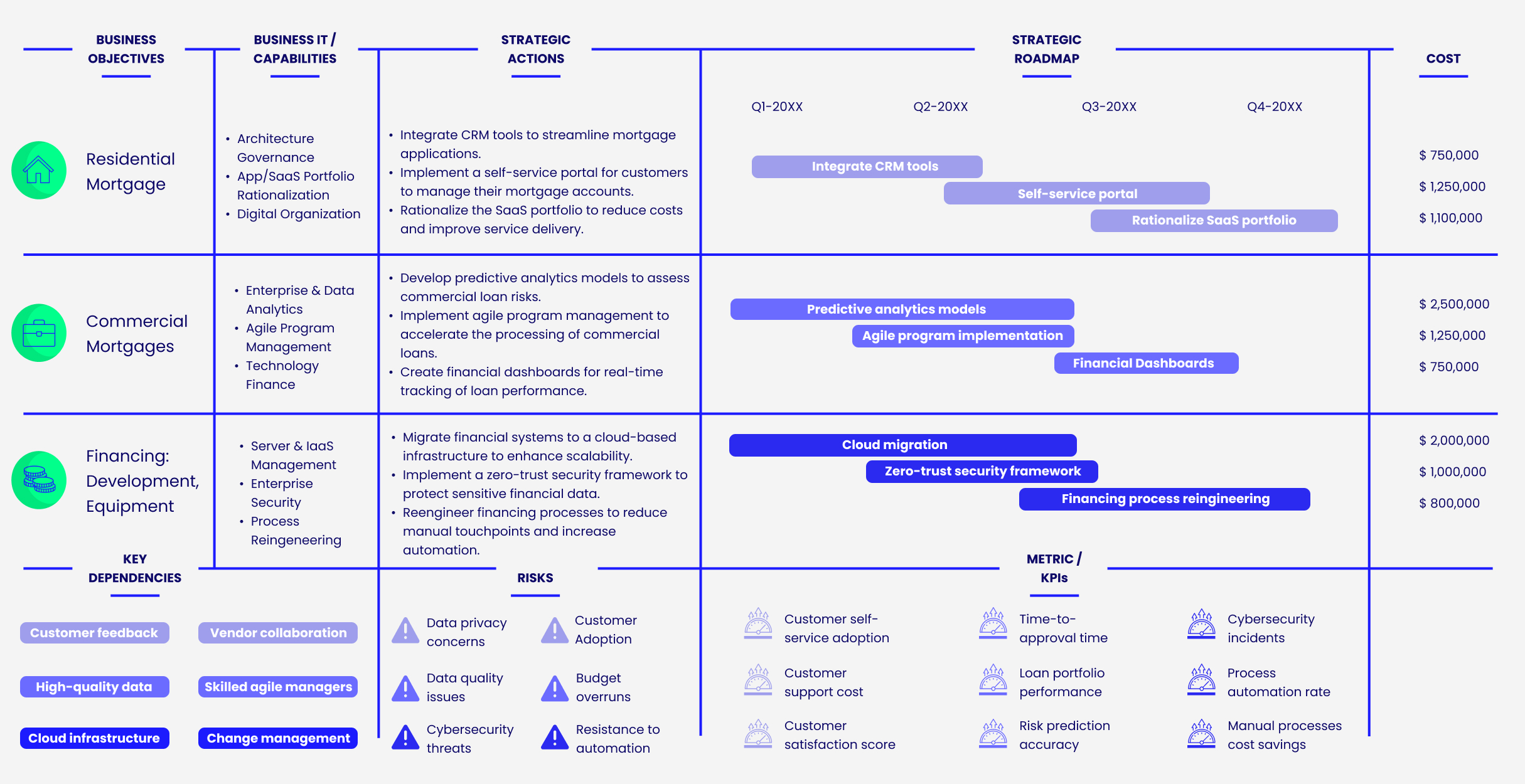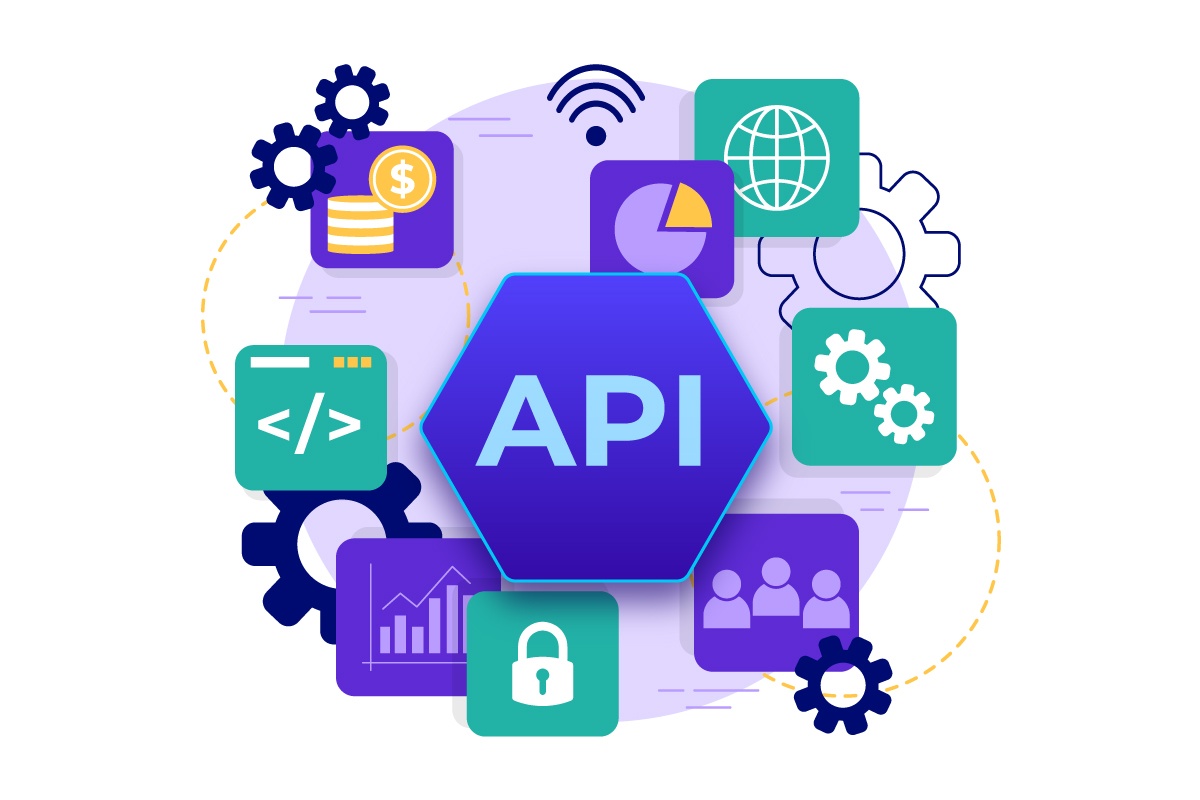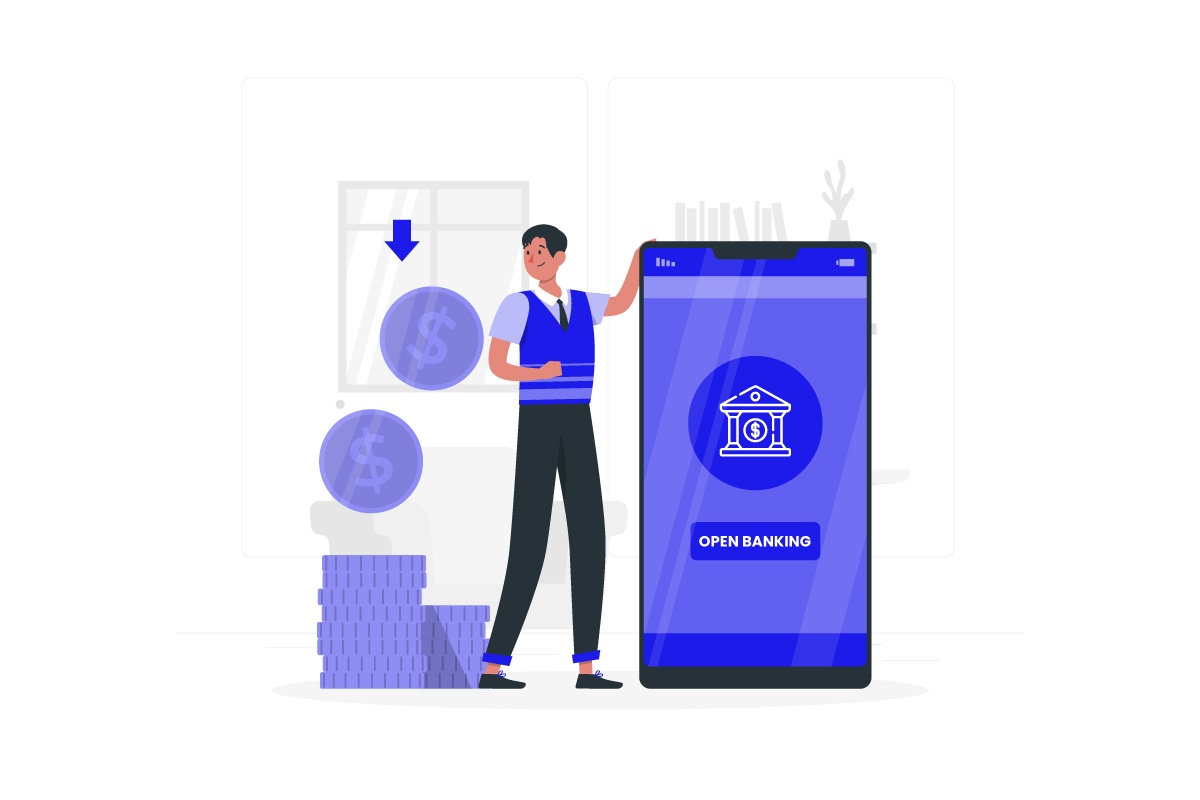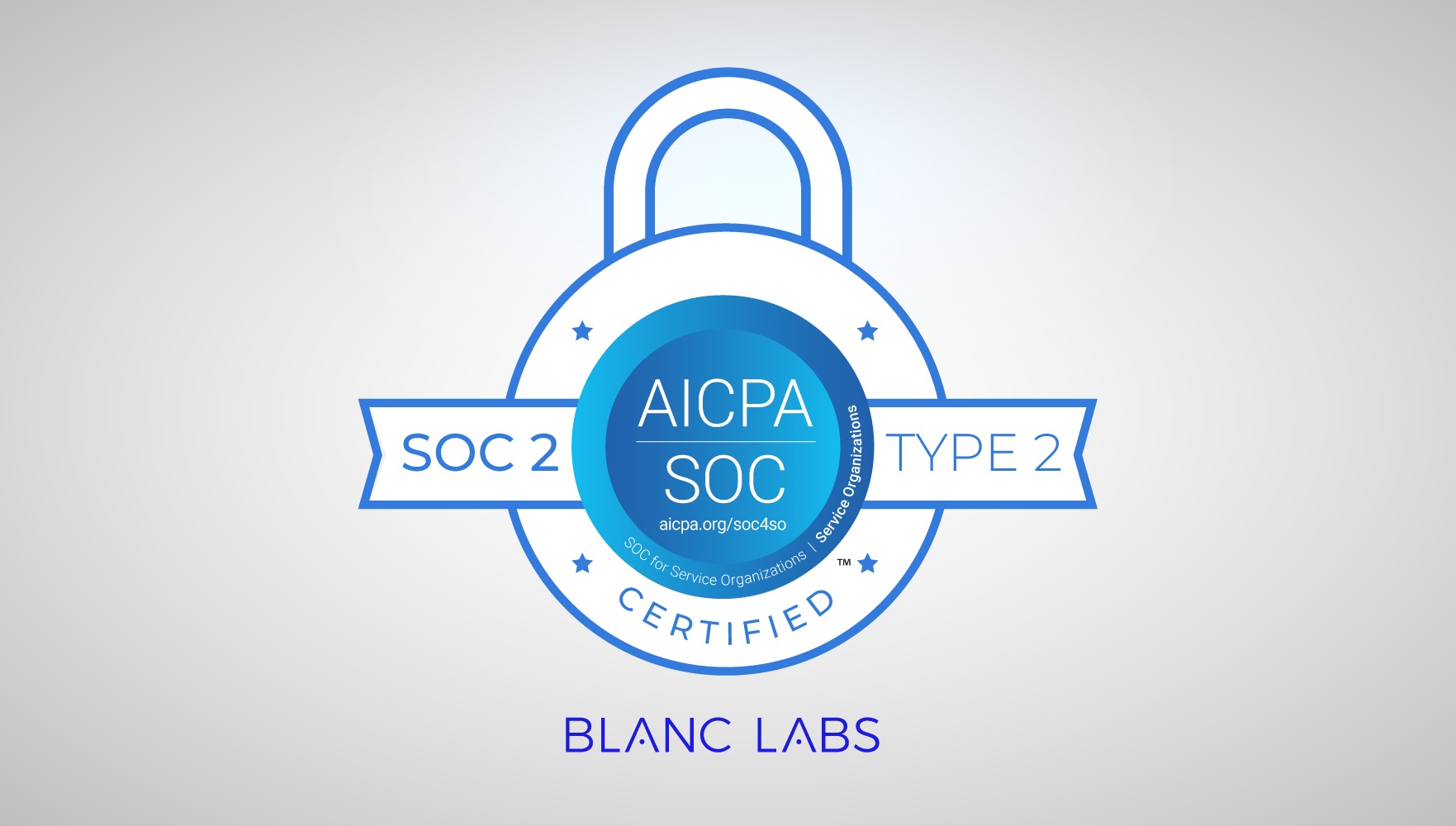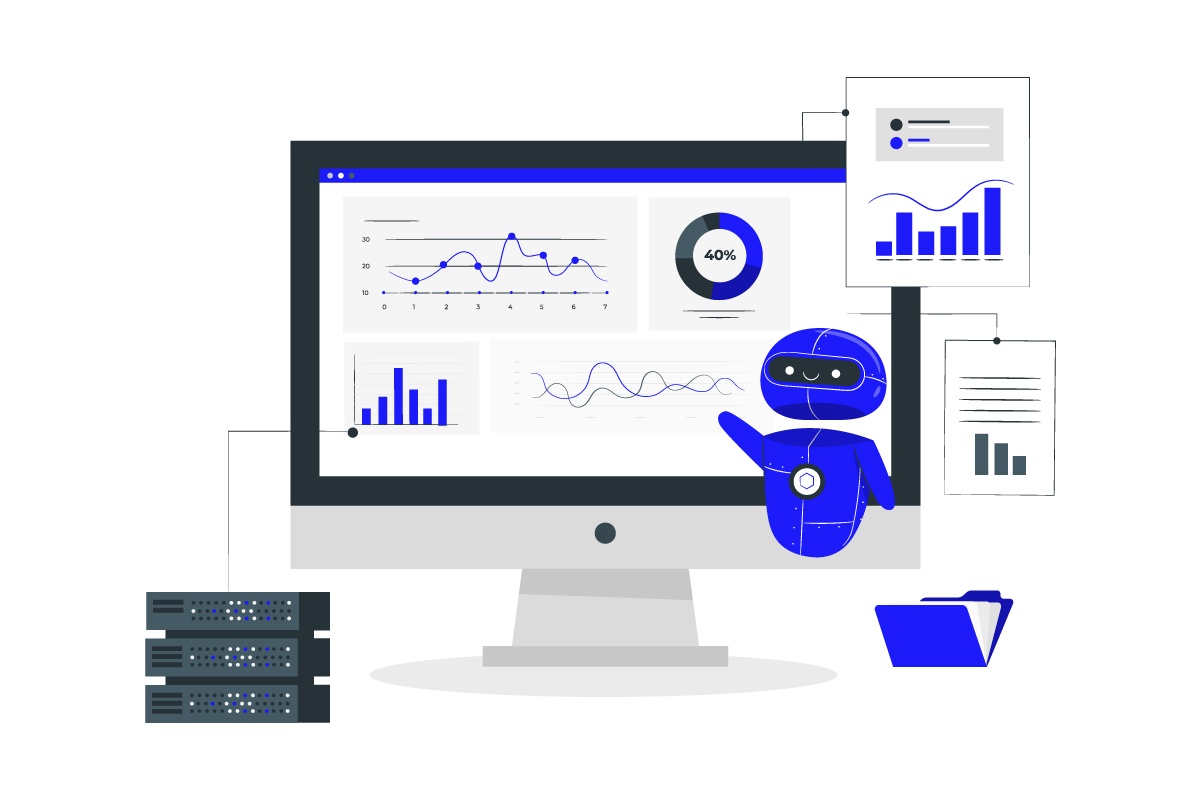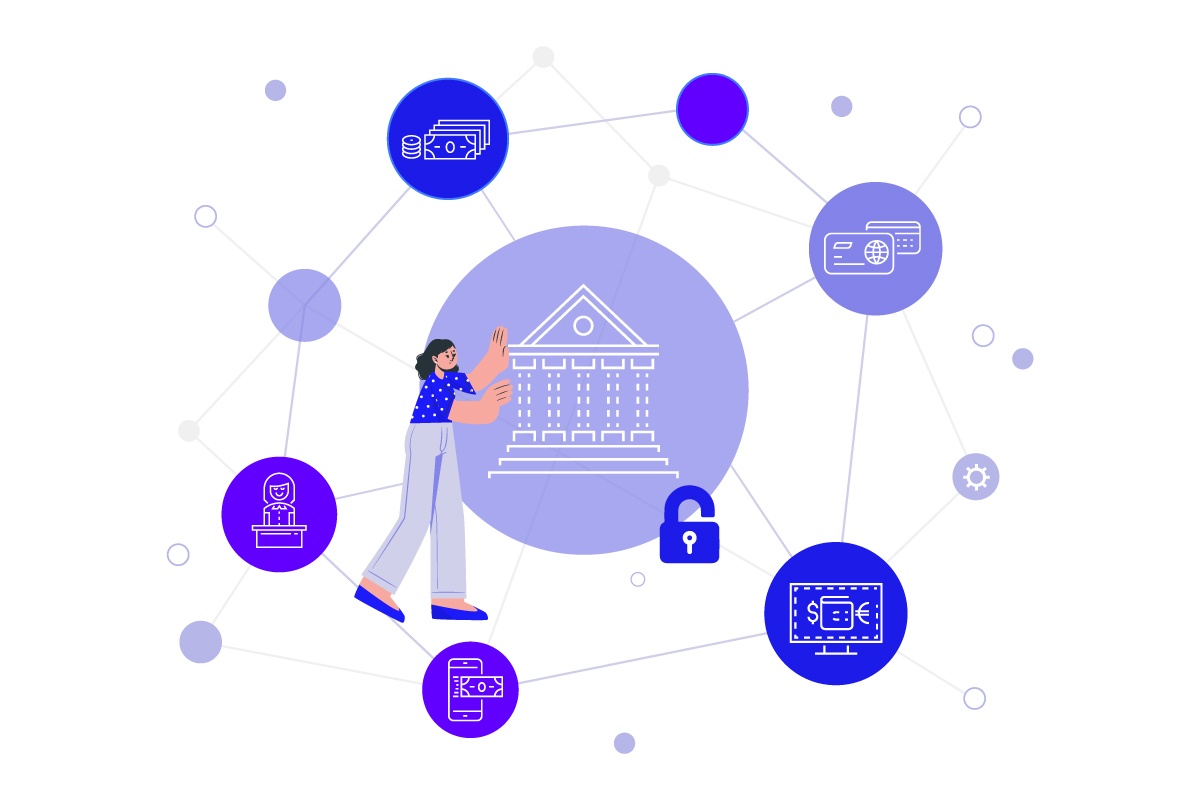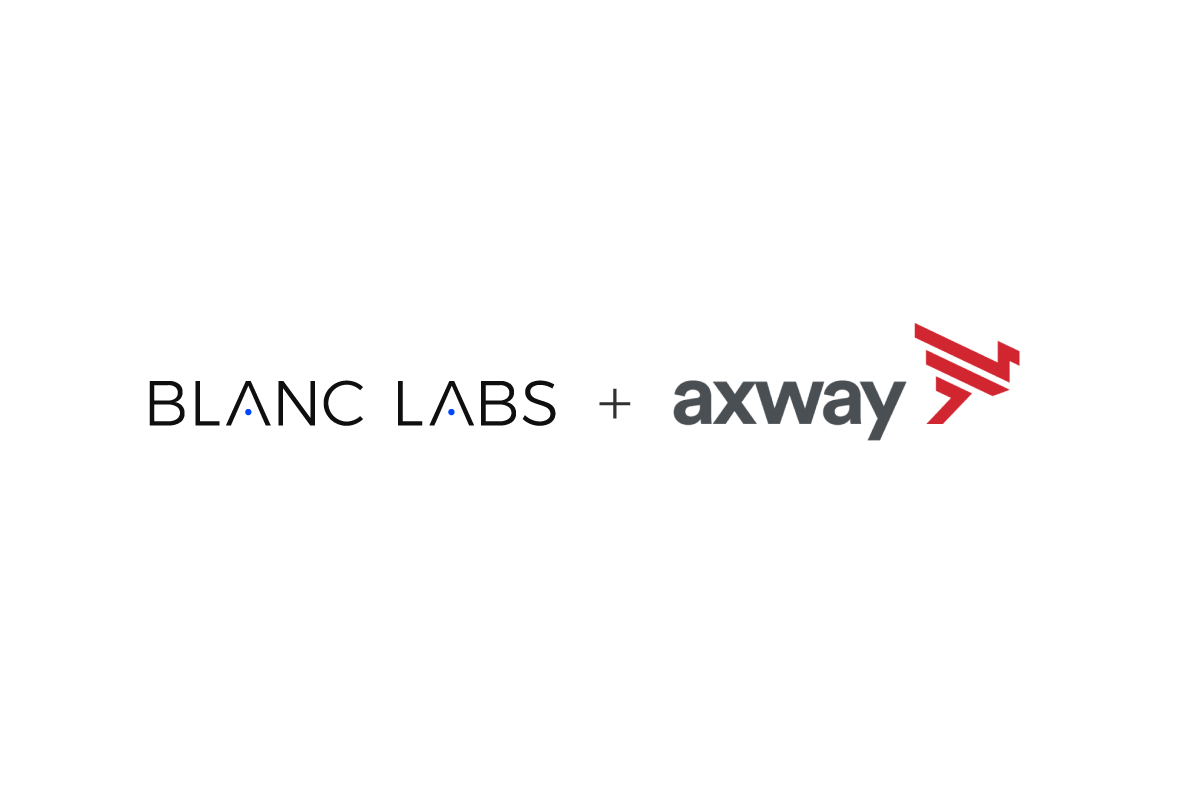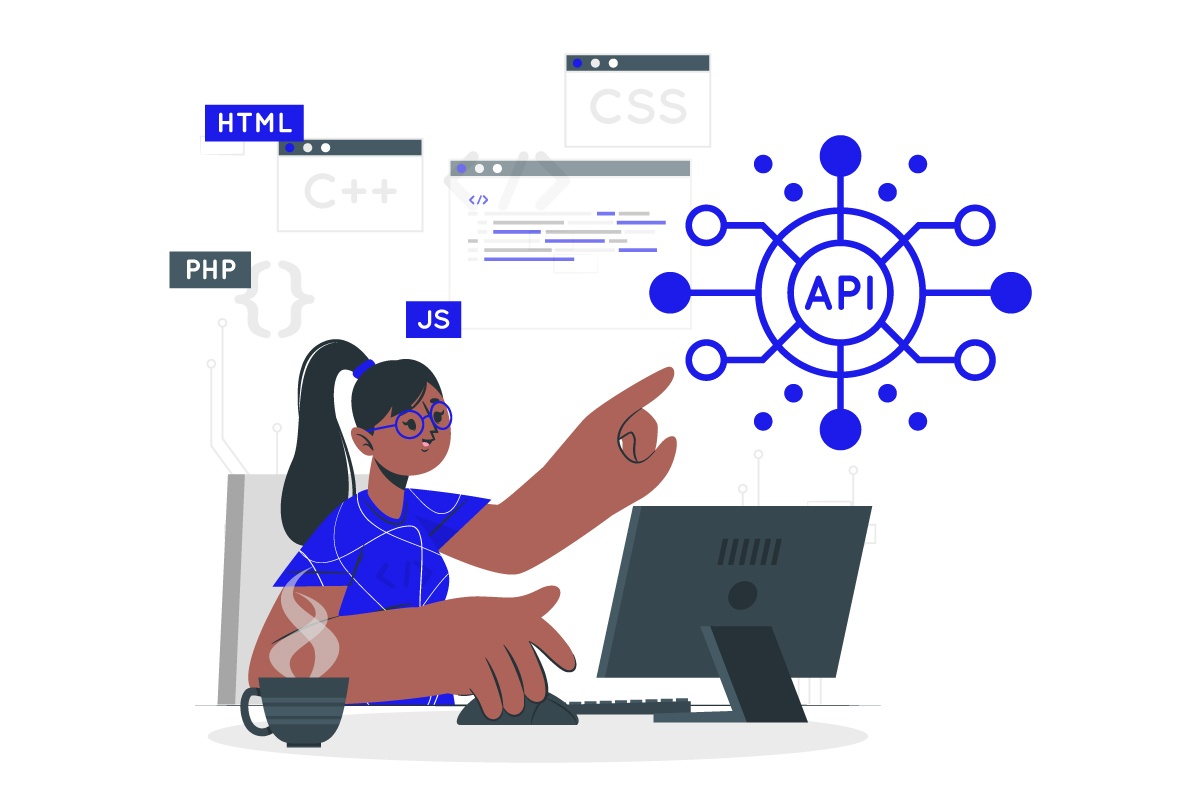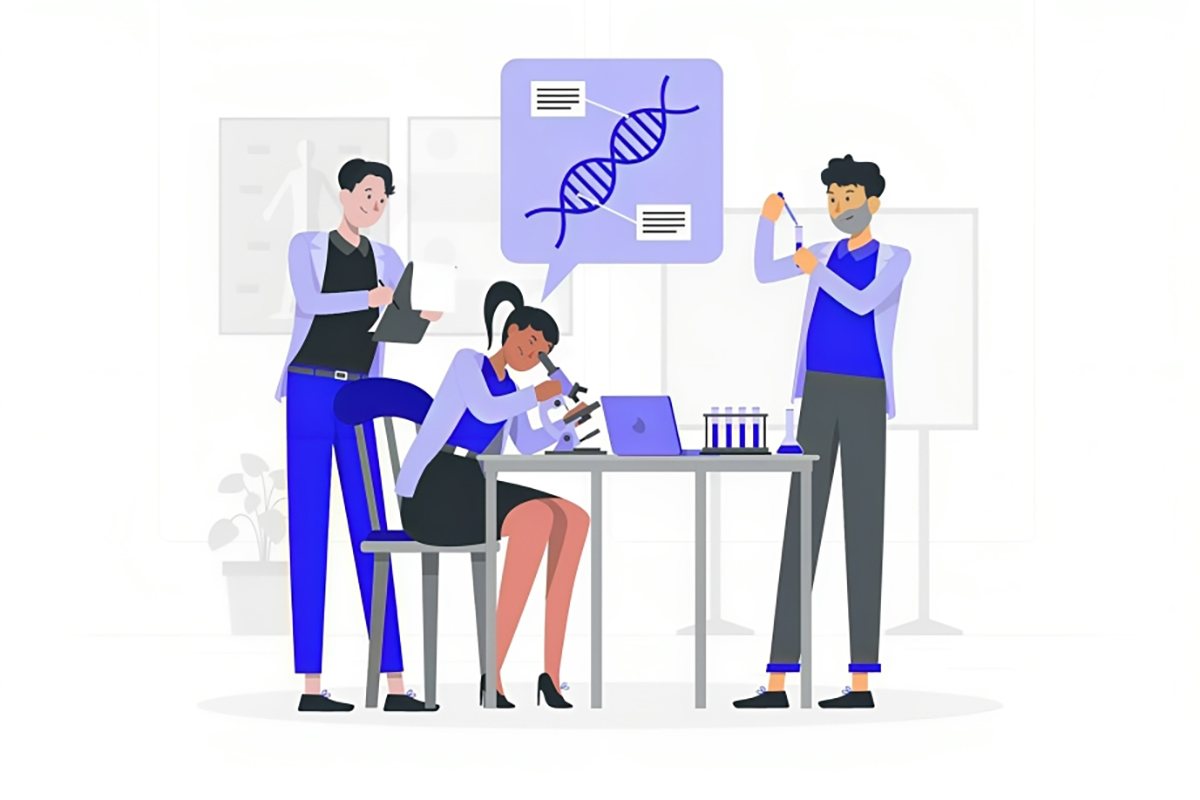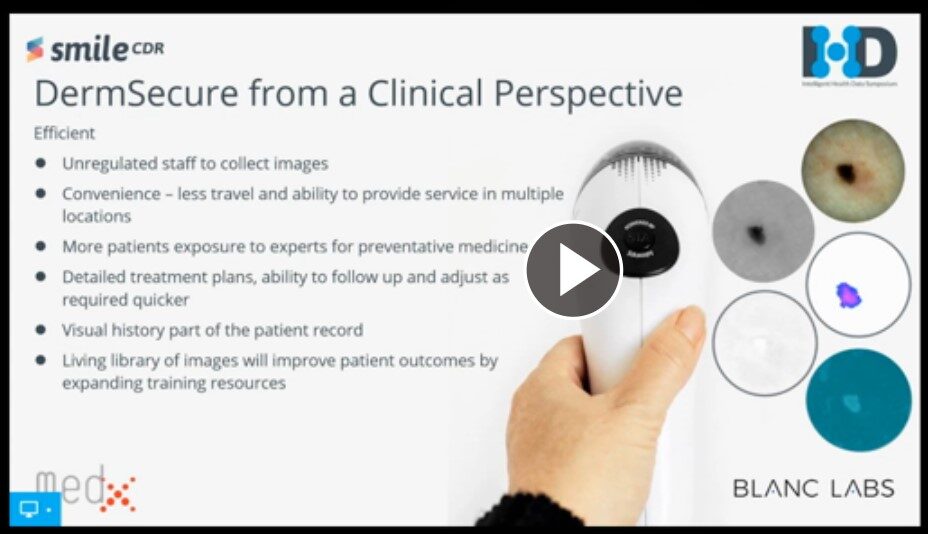Winning the Open Banking Race: A Challenger’s Path to Entering the Ecosystem Economy
Winning the Open Banking Race: A Challenger’s Path to Entering the Ecosystem Economy
February 5, 2024
Capitalizing on the Open Banking Opportunity
This whitepaper provides a practical path to adopting open banking for banks and financial services institutions. It describes the steps that successful early adopters have taken in the process of forming their open banking strategy and executing on it, while balancing the risks and unknowns in markets where regulatory direction was still being formed.
This whitepaper covers:
- Understanding Open Banking: What is it and What is the Opportunity
- Building a Business Case for Open Banking Enablement
- Governance Models
- Technology Strategies for Open Banking
- The Ecosystem Approach for Financial Services
Many of our clients understand that consumer directed finance represents a significant shift in how value will be created and distributed between FI’s and consumers. Knowing how to get started can be daunting and this whitepaper contains recommendations for a “no regrets” approach to make progress when clear guidelines are not yet defined.
The open banking opportunity:



Download the full whitepaper for:
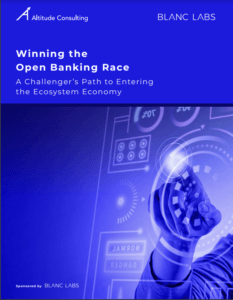
Winning the Open Banking Race whitepaper – Feb 2024
Landing page web created in Feb 2024
https://blanclabs.com/insights/winning-the-open-banking-race-consumer-driven-financeWinning the Open Banking Race whitepaper LP Web
Get in touch

Latest Insights
Canadian IT services firms offer a strategic opportunity for US Banks and FIs

Discover the strategic advantage for U.S. banks embracing innovation with cost-effective Canadian nearshore IT support.
Lenders Transformation Playbook: Bridging Strategy and Execution
AI’s Mid-Market Makeover in Financial Services

Mid-sized financial services institutions (FIs) are facing significant challenges during this period of rapid technological change, particularly with the rise of artificial intelligence (AI). As customer expectations grow, smaller banks and lenders must stay competitive and responsive. Canada’s largest financial institutions are already advancing in AI, while many others remain in ‘observer’ mode, hesitant to invest and experiment. Yet, mid-sized FIs that adopt the right strategy have unique agility, allowing them to adapt swiftly and efficiently to technological disruptions—even more so than their larger counterparts.
Process Improvement and Automation Support the Mission at Trez Capital 🚀

Trez distributes capital based on very specific criteria. But with over 300 investments in their portfolio, they process numerous payment requests and deal with documents in varied data formats. They saw an opportunity to enhance efficiency, improve task management, and better utilize data insights for strategic decision-making.
Align, Assemble, Assure: A Framework for AI Adoption

An in-depth guide for adopting and scaling AI in the enterprise using actionable and measurable steps.
Blanc Labs Welcomes Two New Leaders to Advance AI Innovation and Enhance Tech Advisory Services for Financial Institutions Across North America
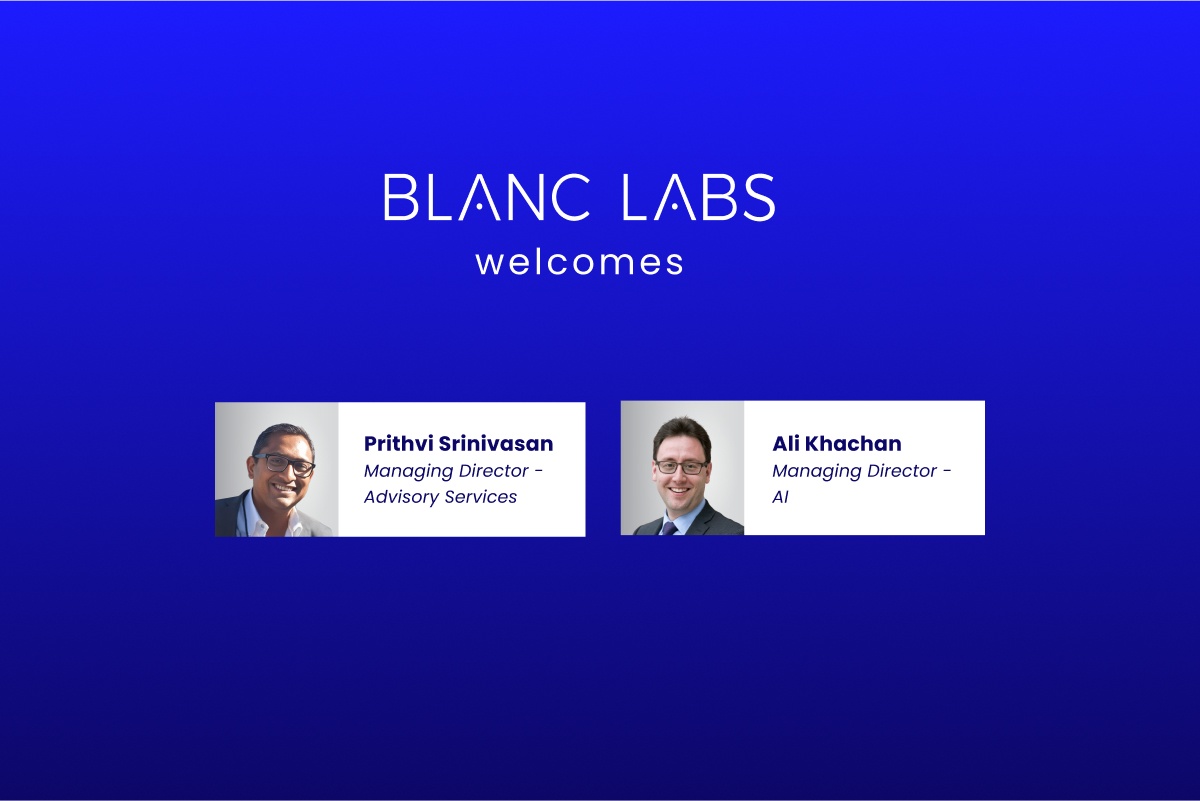
Blanc Labs and TCG Process have partnered to transform lending operations with innovative automation solutions, using the DocProStar platform to enhance efficiency, compliance, and customer satisfaction in the Canadian lending market.
Blanc Labs Partners with TCG Process to Integrate their Automation and Orchestration Platform and deliver Advanced Intelligent Workflow Automation to Financial Institutions

Blanc Labs and TCG Process have partnered to transform lending operations with innovative automation solutions, using the DocProStar platform to enhance efficiency, compliance, and customer satisfaction in the Canadian lending market.
BPI in Banking and Financial Services in the US & Canada

Banking and financial services are changing fast. Moving from old, paper methods to new, digital ones is key to staying in business. It’s important to think about how business process improvement (BPI) can help.
Business Process Improvement vs Business Process Reengineering

Business process improvement vs. reengineering is a tough choice. In this guide, we help you choose between the two based on four factors.
What is the role of a Business Process Improvement Specialist?

A business process improvement specialist identifies bottlenecks and inefficiencies in your workflows, allowing you to focus efforts on automating the right processes.
Open Banking Technology Architecture Whitepaper

We’ve developed this resource to help technical teams adopt an Open Banking approach by explaining a high-level solution architecture that is organization agnostic.
Winning the Open Banking Race: A Challenger’s Path to Entering the Ecosystem Economy

Learn about the steps you can take in forming an open banking strategy and executing on it.
These are not your grandmother’s models: the impact of LLM’s on Document Processing

Explore the transformative influence of large language models (LLMs) on document processing in this insightful article. Discover how these cutting-edge models are reshaping traditional approaches, unlocking new possibilities in data analysis, and revolutionizing the way we interact with information.
From Chaos to Clarity: Achieving Operational Excellence through Business Process Improvement

Discover transformative insights and strategies to streamline operations, enhance efficiency, and drive success.
2023 Fall Economic Update on Consumer-Driven Banking 🥳

Blanc Labs provides their POV on the recent Open Banking Update by the Federal Government.
Finding the right API Management Platform
5 Factors to Evaluate Open Banking Readiness in Canada
Open Banking in Canada: How Banks and Customers Can Benefit
Canadian IT services firms offer a strategic opportunity for US Banks and FIs

Discover the strategic advantage for U.S. banks embracing innovation with cost-effective Canadian nearshore IT support.
Lenders Transformation Playbook: Bridging Strategy and Execution
AI’s Mid-Market Makeover in Financial Services

Mid-sized financial services institutions (FIs) are facing significant challenges during this period of rapid technological change, particularly with the rise of artificial intelligence (AI). As customer expectations grow, smaller banks and lenders must stay competitive and responsive. Canada’s largest financial institutions are already advancing in AI, while many others remain in ‘observer’ mode, hesitant to invest and experiment. Yet, mid-sized FIs that adopt the right strategy have unique agility, allowing them to adapt swiftly and efficiently to technological disruptions—even more so than their larger counterparts.
Process Improvement and Automation Support the Mission at Trez Capital 🚀

Trez distributes capital based on very specific criteria. But with over 300 investments in their portfolio, they process numerous payment requests and deal with documents in varied data formats. They saw an opportunity to enhance efficiency, improve task management, and better utilize data insights for strategic decision-making.
Align, Assemble, Assure: A Framework for AI Adoption

An in-depth guide for adopting and scaling AI in the enterprise using actionable and measurable steps.
Blanc Labs Welcomes Two New Leaders to Advance AI Innovation and Enhance Tech Advisory Services for Financial Institutions Across North America

Blanc Labs and TCG Process have partnered to transform lending operations with innovative automation solutions, using the DocProStar platform to enhance efficiency, compliance, and customer satisfaction in the Canadian lending market.
Blanc Labs Partners with TCG Process to Integrate their Automation and Orchestration Platform and deliver Advanced Intelligent Workflow Automation to Financial Institutions

Blanc Labs and TCG Process have partnered to transform lending operations with innovative automation solutions, using the DocProStar platform to enhance efficiency, compliance, and customer satisfaction in the Canadian lending market.
BPI in Banking and Financial Services in the US & Canada

Banking and financial services are changing fast. Moving from old, paper methods to new, digital ones is key to staying in business. It’s important to think about how business process improvement (BPI) can help.
Business Process Improvement vs Business Process Reengineering

Business process improvement vs. reengineering is a tough choice. In this guide, we help you choose between the two based on four factors.
What is the role of a Business Process Improvement Specialist?

A business process improvement specialist identifies bottlenecks and inefficiencies in your workflows, allowing you to focus efforts on automating the right processes.
Open Banking Technology Architecture Whitepaper

We’ve developed this resource to help technical teams adopt an Open Banking approach by explaining a high-level solution architecture that is organization agnostic.
Winning the Open Banking Race: A Challenger’s Path to Entering the Ecosystem Economy

Learn about the steps you can take in forming an open banking strategy and executing on it.
These are not your grandmother’s models: the impact of LLM’s on Document Processing

Explore the transformative influence of large language models (LLMs) on document processing in this insightful article. Discover how these cutting-edge models are reshaping traditional approaches, unlocking new possibilities in data analysis, and revolutionizing the way we interact with information.
From Chaos to Clarity: Achieving Operational Excellence through Business Process Improvement

Discover transformative insights and strategies to streamline operations, enhance efficiency, and drive success.
2023 Fall Economic Update on Consumer-Driven Banking 🥳

Blanc Labs provides their POV on the recent Open Banking Update by the Federal Government.
Finding the right API Management Platform
5 Factors to Evaluate Open Banking Readiness in Canada
Open Banking in Canada: How Banks and Customers Can Benefit
Canadian IT services firms offer a strategic opportunity for US Banks and FIs

Discover the strategic advantage for U.S. banks embracing innovation with cost-effective Canadian nearshore IT support.
Lenders Transformation Playbook: Bridging Strategy and Execution
AI’s Mid-Market Makeover in Financial Services

Mid-sized financial services institutions (FIs) are facing significant challenges during this period of rapid technological change, particularly with the rise of artificial intelligence (AI). As customer expectations grow, smaller banks and lenders must stay competitive and responsive. Canada’s largest financial institutions are already advancing in AI, while many others remain in ‘observer’ mode, hesitant to invest and experiment. Yet, mid-sized FIs that adopt the right strategy have unique agility, allowing them to adapt swiftly and efficiently to technological disruptions—even more so than their larger counterparts.
Process Improvement and Automation Support the Mission at Trez Capital 🚀

Trez distributes capital based on very specific criteria. But with over 300 investments in their portfolio, they process numerous payment requests and deal with documents in varied data formats. They saw an opportunity to enhance efficiency, improve task management, and better utilize data insights for strategic decision-making.
Align, Assemble, Assure: A Framework for AI Adoption

An in-depth guide for adopting and scaling AI in the enterprise using actionable and measurable steps.
Blanc Labs Welcomes Two New Leaders to Advance AI Innovation and Enhance Tech Advisory Services for Financial Institutions Across North America

Blanc Labs and TCG Process have partnered to transform lending operations with innovative automation solutions, using the DocProStar platform to enhance efficiency, compliance, and customer satisfaction in the Canadian lending market.
Blanc Labs Partners with TCG Process to Integrate their Automation and Orchestration Platform and deliver Advanced Intelligent Workflow Automation to Financial Institutions

Blanc Labs and TCG Process have partnered to transform lending operations with innovative automation solutions, using the DocProStar platform to enhance efficiency, compliance, and customer satisfaction in the Canadian lending market.
BPI in Banking and Financial Services in the US & Canada

Banking and financial services are changing fast. Moving from old, paper methods to new, digital ones is key to staying in business. It’s important to think about how business process improvement (BPI) can help.
Business Process Improvement vs Business Process Reengineering

Business process improvement vs. reengineering is a tough choice. In this guide, we help you choose between the two based on four factors.
What is the role of a Business Process Improvement Specialist?

A business process improvement specialist identifies bottlenecks and inefficiencies in your workflows, allowing you to focus efforts on automating the right processes.
Open Banking Technology Architecture Whitepaper

We’ve developed this resource to help technical teams adopt an Open Banking approach by explaining a high-level solution architecture that is organization agnostic.
Winning the Open Banking Race: A Challenger’s Path to Entering the Ecosystem Economy

Learn about the steps you can take in forming an open banking strategy and executing on it.
These are not your grandmother’s models: the impact of LLM’s on Document Processing

Explore the transformative influence of large language models (LLMs) on document processing in this insightful article. Discover how these cutting-edge models are reshaping traditional approaches, unlocking new possibilities in data analysis, and revolutionizing the way we interact with information.
From Chaos to Clarity: Achieving Operational Excellence through Business Process Improvement

Discover transformative insights and strategies to streamline operations, enhance efficiency, and drive success.
2023 Fall Economic Update on Consumer-Driven Banking 🥳

Blanc Labs provides their POV on the recent Open Banking Update by the Federal Government.
Finding the right API Management Platform
5 Factors to Evaluate Open Banking Readiness in Canada
Open Banking in Canada: How Banks and Customers Can Benefit
Canadian IT services firms offer a strategic opportunity for US Banks and FIs
Canadian IT services firms offer a strategic opportunity for US Banks and FIs
January 29, 2024
In today’s challenging environment, U.S. bank IT departments are under unprecedented pressure to deliver more with limited resources. Cost-effective Canadian nearshore IT support, especially from technology-rich regions like Toronto, are emerging as a compelling opportunity for U.S. banks seeking to transform their technology infrastructure and enhance operational efficiency.
Toronto: Access to World-Class Technology Talent
Toronto is recognized globally as a Canadian center for technology and fintech companies. This world-class and fast growing city with 6.5 million citizens in 2023 is a dynamic and creative urban environment that at this point has become a self-sustaining financial technology hub, making it an ideal partner for U.S. banks seeking talent to drive their transformation roadmaps further and faster.
The region is home to top-tier universities like the University of Toronto, Waterloo and York University are renowned for their research and technology programs, providing a steady stream of skilled graduates and fostering a culture of innovation. Additionally, Toronto hosts the MaRS Discovery District, one of the world’s largest urban innovation hubs. MaRS provides a platform for tech start-ups and entrepreneurs, further solidifying Toronto’s status as a leader in technological development and innovation.
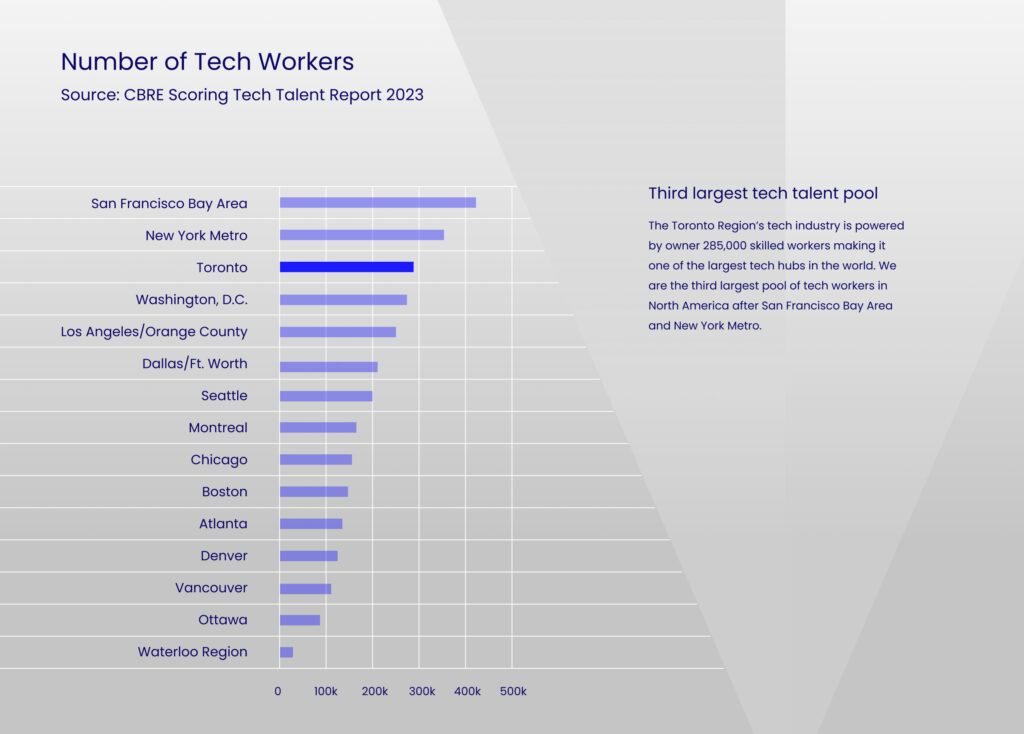
Proximity and Time Zone Alignment
Toronto’s geographical proximity, where almost any major U.S. city can be easily reached with a short, direct flight, offers significant benefits, including time zone alignment for real-time collaboration and agile project management. This is particularly advantageous compared to offshoring and other options. The ease of travel not only strengthens business relationships but also ensures effective communication and alignment, which are critical for the success of complex IT projects.
Cost-Effectiveness
Choosing Toronto for nearshore IT support allows U.S. banks to maintain high service standards while managing operational costs. The significant savings, often ranging from 30-50%, are a result of the current exchange rate differences between the U.S. and Canada, coupled with the inherent efficiencies in project management and execution. These financial benefits can be redirected towards other areas of growth and innovation.
Regulatory and Cultural Alignment
The U.S. and Canada share many regulatory and cultural similarities, which simplifies compliance standards and business practice alignment. This is vital for U.S. banks to minimize legal and operational risks in the highly regulated banking sector.
Customized and Scalable Solutions
Nearshore IT support in Toronto offers tailored, scalable solutions to meet specific banking needs. This flexibility ensures IT services adapt to the bank’s growth and changing priorities, promoting long-term sustainability. Moreover, these solutions are market-proven and highly relevant for U.S. banks, having been successfully implemented and delivering tangible results in similar banking environments.
Enhanced Security
Canadian nearshore IT support provides enhanced security, ensuring compliance with North American data protection laws. This safeguards sensitive information and customer data. Look for a SOC2 certification, which signifies a firm that can adapt to the stringent security requirements, a crucial aspect for U.S. banks in safeguarding their operations and customer information.
Looking for a Canadian tech partner? Let us help.
For U.S. banks striving to stay ahead in innovation, cost-effective Canadian nearshore IT support is a compelling strategic choice. Partnering with Toronto-based firms, such as Blanc Labs, maximizes these benefits, leading to improved efficiencies, fostering innovation, and enhancing customer satisfaction, significantly contributing to the bank’s success.
Author

Les Riedl, Managing Principal of 10XBizDEV, is dedicated to connecting US Banks with innovative, best-in-class solutions and services that contribute to their success. His extensive experience as CEO and board member in fintech and financial services consulting provides valuable insights into the sector’s evolving challenges and opportunities. As US advisor for Blanc Labs, Les is instrumental in introducing their world-class capabilities to the American market.
Related Insights
Lenders Transformation Playbook: Bridging Strategy and Execution
AI’s Mid-Market Makeover in Financial Services

Mid-sized financial services institutions (FIs) are facing significant challenges during this period of rapid technological change, particularly with the rise of artificial intelligence (AI). As customer expectations grow, smaller banks and lenders must stay competitive and responsive. Canada’s largest financial institutions are already advancing in AI, while many others remain in ‘observer’ mode, hesitant to invest and experiment. Yet, mid-sized FIs that adopt the right strategy have unique agility, allowing them to adapt swiftly and efficiently to technological disruptions—even more so than their larger counterparts.
Process Improvement and Automation Support the Mission at Trez Capital 🚀

Trez distributes capital based on very specific criteria. But with over 300 investments in their portfolio, they process numerous payment requests and deal with documents in varied data formats. They saw an opportunity to enhance efficiency, improve task management, and better utilize data insights for strategic decision-making.
Align, Assemble, Assure: A Framework for AI Adoption

An in-depth guide for adopting and scaling AI in the enterprise using actionable and measurable steps.
Blanc Labs Welcomes Two New Leaders to Advance AI Innovation and Enhance Tech Advisory Services for Financial Institutions Across North America

Blanc Labs and TCG Process have partnered to transform lending operations with innovative automation solutions, using the DocProStar platform to enhance efficiency, compliance, and customer satisfaction in the Canadian lending market.
Blanc Labs Partners with TCG Process to Integrate their Automation and Orchestration Platform and deliver Advanced Intelligent Workflow Automation to Financial Institutions

Blanc Labs and TCG Process have partnered to transform lending operations with innovative automation solutions, using the DocProStar platform to enhance efficiency, compliance, and customer satisfaction in the Canadian lending market.
BPI in Banking and Financial Services in the US & Canada

Banking and financial services are changing fast. Moving from old, paper methods to new, digital ones is key to staying in business. It’s important to think about how business process improvement (BPI) can help.
Business Process Improvement vs Business Process Reengineering

Business process improvement vs. reengineering is a tough choice. In this guide, we help you choose between the two based on four factors.
What is the role of a Business Process Improvement Specialist?

A business process improvement specialist identifies bottlenecks and inefficiencies in your workflows, allowing you to focus efforts on automating the right processes.
Open Banking Technology Architecture Whitepaper

We’ve developed this resource to help technical teams adopt an Open Banking approach by explaining a high-level solution architecture that is organization agnostic.
Winning the Open Banking Race: A Challenger’s Path to Entering the Ecosystem Economy

Learn about the steps you can take in forming an open banking strategy and executing on it.
Canadian IT services firms offer a strategic opportunity for US Banks and FIs

Discover the strategic advantage for U.S. banks embracing innovation with cost-effective Canadian nearshore IT support.
These are not your grandmother’s models: the impact of LLM’s on Document Processing

Explore the transformative influence of large language models (LLMs) on document processing in this insightful article. Discover how these cutting-edge models are reshaping traditional approaches, unlocking new possibilities in data analysis, and revolutionizing the way we interact with information.
From Chaos to Clarity: Achieving Operational Excellence through Business Process Improvement

Discover transformative insights and strategies to streamline operations, enhance efficiency, and drive success.
The Keys to the Secret Garden: Unlocking the Potential of AI in the Enterprise

In this article, Dave Offierski explores the conditions to support enterprise AI adoption.
Blanc Labs Achieves SOC 2 Type 2 Certification
Banking Automation: The Complete Guide
The Transformative Power of Banking Automation
Lenders Transformation Playbook: Bridging Strategy and Execution
AI’s Mid-Market Makeover in Financial Services

Mid-sized financial services institutions (FIs) are facing significant challenges during this period of rapid technological change, particularly with the rise of artificial intelligence (AI). As customer expectations grow, smaller banks and lenders must stay competitive and responsive. Canada’s largest financial institutions are already advancing in AI, while many others remain in ‘observer’ mode, hesitant to invest and experiment. Yet, mid-sized FIs that adopt the right strategy have unique agility, allowing them to adapt swiftly and efficiently to technological disruptions—even more so than their larger counterparts.
Process Improvement and Automation Support the Mission at Trez Capital 🚀

Trez distributes capital based on very specific criteria. But with over 300 investments in their portfolio, they process numerous payment requests and deal with documents in varied data formats. They saw an opportunity to enhance efficiency, improve task management, and better utilize data insights for strategic decision-making.
Align, Assemble, Assure: A Framework for AI Adoption

An in-depth guide for adopting and scaling AI in the enterprise using actionable and measurable steps.
Blanc Labs Welcomes Two New Leaders to Advance AI Innovation and Enhance Tech Advisory Services for Financial Institutions Across North America

Blanc Labs and TCG Process have partnered to transform lending operations with innovative automation solutions, using the DocProStar platform to enhance efficiency, compliance, and customer satisfaction in the Canadian lending market.
Blanc Labs Partners with TCG Process to Integrate their Automation and Orchestration Platform and deliver Advanced Intelligent Workflow Automation to Financial Institutions

Blanc Labs and TCG Process have partnered to transform lending operations with innovative automation solutions, using the DocProStar platform to enhance efficiency, compliance, and customer satisfaction in the Canadian lending market.
BPI in Banking and Financial Services in the US & Canada

Banking and financial services are changing fast. Moving from old, paper methods to new, digital ones is key to staying in business. It’s important to think about how business process improvement (BPI) can help.
Business Process Improvement vs Business Process Reengineering

Business process improvement vs. reengineering is a tough choice. In this guide, we help you choose between the two based on four factors.
What is the role of a Business Process Improvement Specialist?

A business process improvement specialist identifies bottlenecks and inefficiencies in your workflows, allowing you to focus efforts on automating the right processes.
Open Banking Technology Architecture Whitepaper

We’ve developed this resource to help technical teams adopt an Open Banking approach by explaining a high-level solution architecture that is organization agnostic.
Winning the Open Banking Race: A Challenger’s Path to Entering the Ecosystem Economy

Learn about the steps you can take in forming an open banking strategy and executing on it.
Canadian IT services firms offer a strategic opportunity for US Banks and FIs

Discover the strategic advantage for U.S. banks embracing innovation with cost-effective Canadian nearshore IT support.
These are not your grandmother’s models: the impact of LLM’s on Document Processing

Explore the transformative influence of large language models (LLMs) on document processing in this insightful article. Discover how these cutting-edge models are reshaping traditional approaches, unlocking new possibilities in data analysis, and revolutionizing the way we interact with information.
From Chaos to Clarity: Achieving Operational Excellence through Business Process Improvement

Discover transformative insights and strategies to streamline operations, enhance efficiency, and drive success.
The Keys to the Secret Garden: Unlocking the Potential of AI in the Enterprise

In this article, Dave Offierski explores the conditions to support enterprise AI adoption.
Blanc Labs Achieves SOC 2 Type 2 Certification
Banking Automation: The Complete Guide
The Transformative Power of Banking Automation
Lenders Transformation Playbook: Bridging Strategy and Execution
AI’s Mid-Market Makeover in Financial Services

Mid-sized financial services institutions (FIs) are facing significant challenges during this period of rapid technological change, particularly with the rise of artificial intelligence (AI). As customer expectations grow, smaller banks and lenders must stay competitive and responsive. Canada’s largest financial institutions are already advancing in AI, while many others remain in ‘observer’ mode, hesitant to invest and experiment. Yet, mid-sized FIs that adopt the right strategy have unique agility, allowing them to adapt swiftly and efficiently to technological disruptions—even more so than their larger counterparts.
Process Improvement and Automation Support the Mission at Trez Capital 🚀

Trez distributes capital based on very specific criteria. But with over 300 investments in their portfolio, they process numerous payment requests and deal with documents in varied data formats. They saw an opportunity to enhance efficiency, improve task management, and better utilize data insights for strategic decision-making.
Align, Assemble, Assure: A Framework for AI Adoption

An in-depth guide for adopting and scaling AI in the enterprise using actionable and measurable steps.
Blanc Labs Welcomes Two New Leaders to Advance AI Innovation and Enhance Tech Advisory Services for Financial Institutions Across North America

Blanc Labs and TCG Process have partnered to transform lending operations with innovative automation solutions, using the DocProStar platform to enhance efficiency, compliance, and customer satisfaction in the Canadian lending market.
Blanc Labs Partners with TCG Process to Integrate their Automation and Orchestration Platform and deliver Advanced Intelligent Workflow Automation to Financial Institutions

Blanc Labs and TCG Process have partnered to transform lending operations with innovative automation solutions, using the DocProStar platform to enhance efficiency, compliance, and customer satisfaction in the Canadian lending market.
BPI in Banking and Financial Services in the US & Canada

Banking and financial services are changing fast. Moving from old, paper methods to new, digital ones is key to staying in business. It’s important to think about how business process improvement (BPI) can help.
Business Process Improvement vs Business Process Reengineering

Business process improvement vs. reengineering is a tough choice. In this guide, we help you choose between the two based on four factors.
What is the role of a Business Process Improvement Specialist?

A business process improvement specialist identifies bottlenecks and inefficiencies in your workflows, allowing you to focus efforts on automating the right processes.
Open Banking Technology Architecture Whitepaper

We’ve developed this resource to help technical teams adopt an Open Banking approach by explaining a high-level solution architecture that is organization agnostic.
Winning the Open Banking Race: A Challenger’s Path to Entering the Ecosystem Economy

Learn about the steps you can take in forming an open banking strategy and executing on it.
Canadian IT services firms offer a strategic opportunity for US Banks and FIs

Discover the strategic advantage for U.S. banks embracing innovation with cost-effective Canadian nearshore IT support.
These are not your grandmother’s models: the impact of LLM’s on Document Processing

Explore the transformative influence of large language models (LLMs) on document processing in this insightful article. Discover how these cutting-edge models are reshaping traditional approaches, unlocking new possibilities in data analysis, and revolutionizing the way we interact with information.
From Chaos to Clarity: Achieving Operational Excellence through Business Process Improvement

Discover transformative insights and strategies to streamline operations, enhance efficiency, and drive success.
The Keys to the Secret Garden: Unlocking the Potential of AI in the Enterprise

In this article, Dave Offierski explores the conditions to support enterprise AI adoption.
Blanc Labs Achieves SOC 2 Type 2 Certification
Banking Automation: The Complete Guide
The Transformative Power of Banking Automation
These are not your grandmother’s models: the impact of LLM’s on Document Processing
These are not your grandmother’s models: the impact of LLM’s on Document Processing
January 22, 2024
Document Processing before LLMs
Document processing primarily relies on rule-based systems and keyword matching, which can be effective for structured or even semi-structured documents with predictable formats. However, this approach often struggles with unstructured data, where variability and complexity are high. In contrast, Large Language Models (LLMs) bring a transformative approach to document understanding. They leverage advanced natural language processing (NLP) techniques, enabling them to comprehend context, semantics, and nuanced language variations in documents.
In the ever-evolving world of data science and enterprise automation, the explosive growth of unstructured data generated by companies has been a major challenge for data scientists. To give you a sense of scale, recent studies show we’re likely to witness a surge from 33 zettabytes in 2018 to a predicted 175 zettabytes by 2025. Furthermore, according to Gartner, unstructured data currently represents an estimated 80 to 90 percent of all new enterprise data. Unstructured data can include conversations through e-mail or text messages, but also social media posts, blogs, video, audio, call logs, reviews, customer feedback, and replies in questionnaires. This trend spotlights an urgent need for more sophisticated tools to create value from this burgeoning data deluge.
Our team has over 5 years working with various OCR and NLP technologies, including having developed and training models in-house. Don’t get me wrong, IDP tech has come an extremely long way and the tools have gotten tremendously powerful. Libraries such as Amazon Textract (among many others) provide ML engineers a powerful suite of tools to accelerate the speed and quality of applying intelligent document processing to automation scenarios.
However, there are still limitations to how IDP can be adopted to a range of automation scenarios that we encounter in enterprise environments.
Think of traditional models document processing tech as a diligent yet somewhat myopic librarian, meticulously following rules but often missing the bigger picture. In contrast, Large Language Models (LLMs) are like Sherlock Holmes — insightful, context-aware, omnipresent, and adept at deciphering the most cryptic of texts.
This results in several key benefits and improvements:
Enhanced Comprehension
Traditional Method: Typically relies on keyword spotting and pattern recognition. For example, extracting dates or specific terms from structured forms.
LLMs Approach: Goes beyond mere pattern recognition. It interprets language nuances and intent, essential in contexts like financial and legal document analysis where the meaning of clauses and data can be complex.
Flexibility with Unstructured Data
Traditional Method: Struggles with documents like unstructured emails or reports, often leading to high error rates or the need for manual intervention.
LLMs Approach: Excel in handling unstructured formats. For instance, in customer service, LLMs can analyze and respond to diverse customer queries that vary in structure and content, easily extract information from employment letters or mortgage commitment statements.
Dealing with unstructured data, which includes everything from casual emails to social media chatter, videos, and customer feedback, is not a trivial matter. This kind of data resists neat categorization and defies traditional database structures, posing significant challenges in analysis and comprehension. Here’s where Large Language Models show their mettle, adeptly navigating this complex, non-uniform data and unlocking valuable insights that conventional methods might miss.
Adaptive Learning
Traditional Method: Updating rule-based systems for new formats or languages is time-consuming and resource-intensive.
LLMs Approach: Can continuously learn from new data, adapting to changes in language usage or document formats without extensive manual reprogramming.
Error Reduction
Traditional Method: Prone to errors in cases of ambiguous or context-heavy information, resulting in lower reliability.
LLMs Approach: Their deep contextual understanding leads to more accurate data extraction and interpretation, crucial in high-stakes industries like legal, financial and healthcare.
A Practical Example
ChatGPT 4, without any specific fine tuning or pre-training is able to easily extract information from a document it has never seen before. It understands the context and you can simply query in a natural way for data points that you are interested in:
*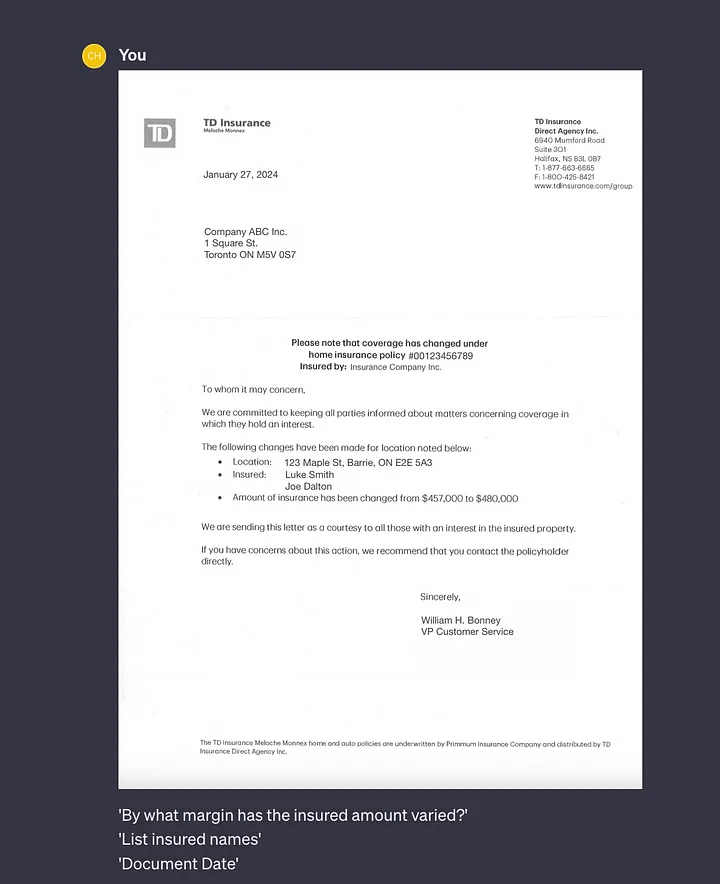
* Note: we take data privacy and PII seriously (see below) and created “spoof” documents for the purposes of this demonstration.
For instance, by asking direct questions such as ‘What is the policy end date?’ or ‘By what margin has the insured amount varied?’, it promptly delivers precise information with perfect accuracy.

This scenario offers the opportunity to further explore solutions that leverage the unique capabilities of LLM’s for the purposes of intelligent document processing and automation.
Generative AI-Powered Extraction and Comparison of Insurance Policy Documents
In the previous section, we delved into the capabilities of Language Learning Models (LLMs) in streamlining the extraction of key information from various document types. To demonstrate this further, we now present a practical application of our system.
The first part of the demonstration involves uploading the initial insurance policy, which acts as our benchmark document. Watch how the system seamlessly processes this document, effortlessly extracting critical details such as the policy number, coverage specifics, the insured party’s information, and other essential data.
Next, we upload a second document representing a modification in the policy. It not only extracts pertinent information from the new document but also conducts an intelligent comparison with the original policy. Notice how the system highlights the changes in the date and insurance limit. This comparative analysis is vital to ensure comprehensive and accurate updates of all modifications and their implications.
To enhance the efficiency of such systems, integration with existing databases and cloud storage services is key. Utilizing APIs, these systems can automatically retrieve documents from various sources such as cloud storage (like AWS S3, Google Cloud Storage), internal databases, or even directly from email attachments. This integration enables real-time processing and updates, ensuring that the latest documents are always analyzed and compared.
The Role of Retrieval-Augmented Generation (RAG) in LLMs
For more context specific answers and solutions, Retrieval-Augmented Generation represents a significant advancement in the capabilities of LLMs. It’s another step forward on this never-ending roller coaster!
- Enhanced Accuracy and Relevance: RAG combines the generative power of LLMs with information retrieval, pulling in relevant data or documents to provide contextually accurate responses. This is particularly beneficial for financial analysis and reporting, where accuracy is paramount.
- Dynamic Data Integration: Unlike traditional LLMs, RAG can integrate real-time data, offering dynamic responses to financial queries. This is essential in finance, where market conditions and regulatory environments are constantly evolving.
- Customized Financial Advice: RAG’s ability to retrieve and process vast amounts of data allows for highly personalized financial advice, tailored to individual customer profiles and market conditions.
- Improved Compliance and Risk Management: In the regulatory-heavy landscape of financial services and healthcare industries, RAG can efficiently process and cross-reference internal and external data sources including detailed regulations and requirements. We believe that there is a huge opportunity to automate regulatory, risk, and compliance checklists to reduce complex manual efforts that exist in regulated industries.
Potential limitations of deploying LLM’s for document processing (at scale)
While LLMs are highly likely to revolutionize document processing with, it is important to consider potential limitations as well. LLMs are like a double-edged sword, powerful in processing vast amounts of data but requiring careful handling to address privacy concerns and manage computing resources.
- Privacy and Personal Identifiable Information (PII): LLMs are capable of processing vast amounts of data, including confidential or proprietary information as well as PII data. Organizations must work within data security frameworks and engineer solutions that have data security at the core of how they are designed and deployed. As a SOC2 Certified company, this is an area of key focus for our teams and we have implemented robust data handling and processing protocols to ensure that all PII is managed securely and in compliance with privacy regulations.
- Computing Power and Cost: The potential impact offered by powerful LLMs to read and extract data from large volumes of unstructured data is reliant on the on substantial computing power required to run these models. We are still in the early stages of enterprise adoption of generative AI technologies and the economics of leveraging these toolsets at an enterprise scale are fairly dynamic. We expect a lot to change over the next few years but in the meantime, we are actively working with clients to understand the business drivers of using LLM’s to automate processes. With our deep background in intelligent document processing we’ve become experts at crafting solutions that optimize model efficiency without compromising performance. We employ techniques like model pruning, efficient data processing pipelines, and cloud-based solutions that balance computational demands with cost-effectiveness.
Conclusion
LLMs and RAG are the vibrant threads bringing new patterns of efficiency, accuracy, and innovation. We’ve journeyed from the meticulous yet narrow pathways of traditional methods to the expansive highways of AI-driven solutions. This evolution isn’t just a step forward; it’s a quantum leap into a future where data isn’t just processed but understood, where advice isn’t just given but tailored, and where compliance isn’t just followed but mastered.
The advancements in unstructured data analytics signal a critical shift in our approach to data. It’s not just about the volume; it’s about the untapped potential that lies within. This raises a compelling question: how can we leverage unstructured data to gain a deeper understanding of our customers, societal trends, and the world at large? The key lies in harmonizing cutting-edge AI tools like Large Language Models with human insight, transforming this wave of data into insightful and actionable knowledge.
References:
- “What is intelligent document processing?” Microsoft
- “OpenAI Research”. OpenAI
- “What is Retrieval-Augmented Generation?” Amazon.
- “Retrieval-Augmented Generation for Knowledge-Intensive NLP Tasks.” IBM.
Harness the power of AI
At Blanc Labs, we specialize in tailoring AI solutions to the specific needs of the Canadian financial and healthcare sector. Our expertise in AI, automation & digital product development positions us to assist in harnessing the power of LLMs and other AI technologies. We provide customized solutions for intelligent document processing, intelligent automation, and enhancing customer experiences, ensuring compliance with industry standards and regulations.
Explore how Blanc Labs can assist your organization in navigating and succeeding in the digital era.
Author

Luciano Lera Bossi is a skilled Engineer with 15+ years of success in tech, specializing in Intelligent Automation, Low Code/No Code and Agile Project Management. He enables effective communication between technical and business stakeholders, resulting in seamless project outcomes.
Related Insights
From Chaos to Clarity: Achieving Operational Excellence through Business Process Improvement

Discover transformative insights and strategies to streamline operations, enhance efficiency, and drive success.
Lenders Transformation Playbook: Bridging Strategy and Execution
AI’s Mid-Market Makeover in Financial Services

Mid-sized financial services institutions (FIs) are facing significant challenges during this period of rapid technological change, particularly with the rise of artificial intelligence (AI). As customer expectations grow, smaller banks and lenders must stay competitive and responsive. Canada’s largest financial institutions are already advancing in AI, while many others remain in ‘observer’ mode, hesitant to invest and experiment. Yet, mid-sized FIs that adopt the right strategy have unique agility, allowing them to adapt swiftly and efficiently to technological disruptions—even more so than their larger counterparts.
Process Improvement and Automation Support the Mission at Trez Capital 🚀

Trez distributes capital based on very specific criteria. But with over 300 investments in their portfolio, they process numerous payment requests and deal with documents in varied data formats. They saw an opportunity to enhance efficiency, improve task management, and better utilize data insights for strategic decision-making.
Align, Assemble, Assure: A Framework for AI Adoption

An in-depth guide for adopting and scaling AI in the enterprise using actionable and measurable steps.
Blanc Labs Welcomes Two New Leaders to Advance AI Innovation and Enhance Tech Advisory Services for Financial Institutions Across North America

Blanc Labs and TCG Process have partnered to transform lending operations with innovative automation solutions, using the DocProStar platform to enhance efficiency, compliance, and customer satisfaction in the Canadian lending market.
Blanc Labs Partners with TCG Process to Integrate their Automation and Orchestration Platform and deliver Advanced Intelligent Workflow Automation to Financial Institutions

Blanc Labs and TCG Process have partnered to transform lending operations with innovative automation solutions, using the DocProStar platform to enhance efficiency, compliance, and customer satisfaction in the Canadian lending market.
BPI in Banking and Financial Services in the US & Canada

Banking and financial services are changing fast. Moving from old, paper methods to new, digital ones is key to staying in business. It’s important to think about how business process improvement (BPI) can help.
Business Process Improvement vs Business Process Reengineering

Business process improvement vs. reengineering is a tough choice. In this guide, we help you choose between the two based on four factors.
What is the role of a Business Process Improvement Specialist?

A business process improvement specialist identifies bottlenecks and inefficiencies in your workflows, allowing you to focus efforts on automating the right processes.
Open Banking Technology Architecture Whitepaper

We’ve developed this resource to help technical teams adopt an Open Banking approach by explaining a high-level solution architecture that is organization agnostic.
Winning the Open Banking Race: A Challenger’s Path to Entering the Ecosystem Economy

Learn about the steps you can take in forming an open banking strategy and executing on it.
Canadian IT services firms offer a strategic opportunity for US Banks and FIs

Discover the strategic advantage for U.S. banks embracing innovation with cost-effective Canadian nearshore IT support.
These are not your grandmother’s models: the impact of LLM’s on Document Processing

Explore the transformative influence of large language models (LLMs) on document processing in this insightful article. Discover how these cutting-edge models are reshaping traditional approaches, unlocking new possibilities in data analysis, and revolutionizing the way we interact with information.
Meet David Liu: COE Lead, Process Improver, and Ramen Aficionado

Meet our new BPI CoE Lead, David Liu! Learn about how he plans to craft efficient processes for enterprise customers and what inspires him to innovate.
The Keys to the Secret Garden: Unlocking the Potential of AI in the Enterprise

In this article, Dave Offierski explores the conditions to support enterprise AI adoption.
Low-Code Tools and Automation Power Minor Ailments Program for Pharmacists

Blanc Labs teamed up with Daylight Automation (acquired by Quadient) to overhaul the process pharmacists use to assess and treat minor ailments, at a critical inflection point for Canadians to efficiently access healthcare services.
From Chaos to Clarity: Achieving Operational Excellence through Business Process Improvement

Discover transformative insights and strategies to streamline operations, enhance efficiency, and drive success.
Lenders Transformation Playbook: Bridging Strategy and Execution
AI’s Mid-Market Makeover in Financial Services

Mid-sized financial services institutions (FIs) are facing significant challenges during this period of rapid technological change, particularly with the rise of artificial intelligence (AI). As customer expectations grow, smaller banks and lenders must stay competitive and responsive. Canada’s largest financial institutions are already advancing in AI, while many others remain in ‘observer’ mode, hesitant to invest and experiment. Yet, mid-sized FIs that adopt the right strategy have unique agility, allowing them to adapt swiftly and efficiently to technological disruptions—even more so than their larger counterparts.
Process Improvement and Automation Support the Mission at Trez Capital 🚀

Trez distributes capital based on very specific criteria. But with over 300 investments in their portfolio, they process numerous payment requests and deal with documents in varied data formats. They saw an opportunity to enhance efficiency, improve task management, and better utilize data insights for strategic decision-making.
Align, Assemble, Assure: A Framework for AI Adoption

An in-depth guide for adopting and scaling AI in the enterprise using actionable and measurable steps.
Blanc Labs Welcomes Two New Leaders to Advance AI Innovation and Enhance Tech Advisory Services for Financial Institutions Across North America

Blanc Labs and TCG Process have partnered to transform lending operations with innovative automation solutions, using the DocProStar platform to enhance efficiency, compliance, and customer satisfaction in the Canadian lending market.
Blanc Labs Partners with TCG Process to Integrate their Automation and Orchestration Platform and deliver Advanced Intelligent Workflow Automation to Financial Institutions

Blanc Labs and TCG Process have partnered to transform lending operations with innovative automation solutions, using the DocProStar platform to enhance efficiency, compliance, and customer satisfaction in the Canadian lending market.
BPI in Banking and Financial Services in the US & Canada

Banking and financial services are changing fast. Moving from old, paper methods to new, digital ones is key to staying in business. It’s important to think about how business process improvement (BPI) can help.
Business Process Improvement vs Business Process Reengineering

Business process improvement vs. reengineering is a tough choice. In this guide, we help you choose between the two based on four factors.
What is the role of a Business Process Improvement Specialist?

A business process improvement specialist identifies bottlenecks and inefficiencies in your workflows, allowing you to focus efforts on automating the right processes.
Open Banking Technology Architecture Whitepaper

We’ve developed this resource to help technical teams adopt an Open Banking approach by explaining a high-level solution architecture that is organization agnostic.
Winning the Open Banking Race: A Challenger’s Path to Entering the Ecosystem Economy

Learn about the steps you can take in forming an open banking strategy and executing on it.
Canadian IT services firms offer a strategic opportunity for US Banks and FIs

Discover the strategic advantage for U.S. banks embracing innovation with cost-effective Canadian nearshore IT support.
These are not your grandmother’s models: the impact of LLM’s on Document Processing

Explore the transformative influence of large language models (LLMs) on document processing in this insightful article. Discover how these cutting-edge models are reshaping traditional approaches, unlocking new possibilities in data analysis, and revolutionizing the way we interact with information.
Meet David Liu: COE Lead, Process Improver, and Ramen Aficionado

Meet our new BPI CoE Lead, David Liu! Learn about how he plans to craft efficient processes for enterprise customers and what inspires him to innovate.
The Keys to the Secret Garden: Unlocking the Potential of AI in the Enterprise

In this article, Dave Offierski explores the conditions to support enterprise AI adoption.
Low-Code Tools and Automation Power Minor Ailments Program for Pharmacists

Blanc Labs teamed up with Daylight Automation (acquired by Quadient) to overhaul the process pharmacists use to assess and treat minor ailments, at a critical inflection point for Canadians to efficiently access healthcare services.
From Chaos to Clarity: Achieving Operational Excellence through Business Process Improvement

Discover transformative insights and strategies to streamline operations, enhance efficiency, and drive success.
Lenders Transformation Playbook: Bridging Strategy and Execution
AI’s Mid-Market Makeover in Financial Services

Mid-sized financial services institutions (FIs) are facing significant challenges during this period of rapid technological change, particularly with the rise of artificial intelligence (AI). As customer expectations grow, smaller banks and lenders must stay competitive and responsive. Canada’s largest financial institutions are already advancing in AI, while many others remain in ‘observer’ mode, hesitant to invest and experiment. Yet, mid-sized FIs that adopt the right strategy have unique agility, allowing them to adapt swiftly and efficiently to technological disruptions—even more so than their larger counterparts.
Process Improvement and Automation Support the Mission at Trez Capital 🚀

Trez distributes capital based on very specific criteria. But with over 300 investments in their portfolio, they process numerous payment requests and deal with documents in varied data formats. They saw an opportunity to enhance efficiency, improve task management, and better utilize data insights for strategic decision-making.
Align, Assemble, Assure: A Framework for AI Adoption

An in-depth guide for adopting and scaling AI in the enterprise using actionable and measurable steps.
Blanc Labs Welcomes Two New Leaders to Advance AI Innovation and Enhance Tech Advisory Services for Financial Institutions Across North America

Blanc Labs and TCG Process have partnered to transform lending operations with innovative automation solutions, using the DocProStar platform to enhance efficiency, compliance, and customer satisfaction in the Canadian lending market.
Blanc Labs Partners with TCG Process to Integrate their Automation and Orchestration Platform and deliver Advanced Intelligent Workflow Automation to Financial Institutions

Blanc Labs and TCG Process have partnered to transform lending operations with innovative automation solutions, using the DocProStar platform to enhance efficiency, compliance, and customer satisfaction in the Canadian lending market.
BPI in Banking and Financial Services in the US & Canada

Banking and financial services are changing fast. Moving from old, paper methods to new, digital ones is key to staying in business. It’s important to think about how business process improvement (BPI) can help.
Business Process Improvement vs Business Process Reengineering

Business process improvement vs. reengineering is a tough choice. In this guide, we help you choose between the two based on four factors.
What is the role of a Business Process Improvement Specialist?

A business process improvement specialist identifies bottlenecks and inefficiencies in your workflows, allowing you to focus efforts on automating the right processes.
Open Banking Technology Architecture Whitepaper

We’ve developed this resource to help technical teams adopt an Open Banking approach by explaining a high-level solution architecture that is organization agnostic.
Winning the Open Banking Race: A Challenger’s Path to Entering the Ecosystem Economy

Learn about the steps you can take in forming an open banking strategy and executing on it.
Canadian IT services firms offer a strategic opportunity for US Banks and FIs

Discover the strategic advantage for U.S. banks embracing innovation with cost-effective Canadian nearshore IT support.
These are not your grandmother’s models: the impact of LLM’s on Document Processing

Explore the transformative influence of large language models (LLMs) on document processing in this insightful article. Discover how these cutting-edge models are reshaping traditional approaches, unlocking new possibilities in data analysis, and revolutionizing the way we interact with information.
Meet David Liu: COE Lead, Process Improver, and Ramen Aficionado

Meet our new BPI CoE Lead, David Liu! Learn about how he plans to craft efficient processes for enterprise customers and what inspires him to innovate.
The Keys to the Secret Garden: Unlocking the Potential of AI in the Enterprise

In this article, Dave Offierski explores the conditions to support enterprise AI adoption.
Low-Code Tools and Automation Power Minor Ailments Program for Pharmacists

Blanc Labs teamed up with Daylight Automation (acquired by Quadient) to overhaul the process pharmacists use to assess and treat minor ailments, at a critical inflection point for Canadians to efficiently access healthcare services.
From Chaos to Clarity: Achieving Operational Excellence through Business Process Improvement
From Chaos to Clarity: Achieving Operational Excellence through Business Process Improvement
January 18, 2024
Generative AI and Automation: Are you implementing them effectively?
The emergence of exponential technologies like Generative AI has sparked enthusiasm among companies and executives, who see the potential for enhancing operations and adding significant value to their businesses. In a PWC survey¹, 86% of U.S. executives projected AI’s transition into a ‘mainstream technology’ within their companies in 2021. Moreover, 25% of businesses utilizing AI anticipate revenue growth.
However, as highlighted by Gartner², a concerning 85% of AI projects ultimately fail to meet their expected business value. Among the numerous factors contributing to these shortcomings, common culprits include misaligned expectations, inadequate planning, and limited comprehension of the technology and its practical applications. When all these factors are considered, they collectively underscore a single underlying issue: an inadequate understanding of the process.
The Cost of No Change
Every business, regardless of its size or industry, operates within a complex web of processes. These processes, when left unoptimized, can lead to chaos, inefficiency, and missed opportunities. Employees may find themselves bogged down in manual tasks, information silos, and redundant workflows. Meanwhile, customers may experience reduced satisfaction due to prolonged or unclear processes and excessive touchpoints, potentially leading to attrition. This chaos not only hampers productivity but can also erode customer satisfaction and profitability.
¹ PricewaterhouseCoopers, “PWC 2022 AI Business Survey”, online: PwC
²“Gartner says nearly half of CIOs are planning to deploy artificial intelligence”, (13 February 2018), online: Gartner
Array’s research³ reveals alarming realities within organizations:
Financial Costs:
Inefficiencies cost 20-30% of revenue.
Time Costs:
Employees lose 26% of their day to avoidable chores.
Recruitment Costs:
Each employee costs $4,129 and 42 days to be trained.
Amid these sobering statistics, businesses have adopted Business Process Improvement as a systematic, analytical approach to understanding, prioritizing, and measuring the impact of how to make their operations run more efficiently.
³Saunders, Dave, “How Much is Inefficiency Costing Your Business”, (19 November 2020), online: Electronic Data
Capture, Mobile Data Collection – Array Survey App



Download the Full Whitepaper
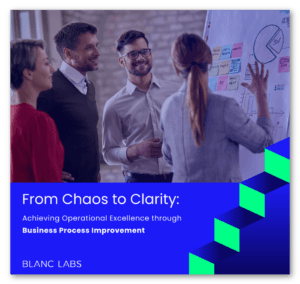
Our teams have compiled insights and best practices in this practical and outcome focused whitepaper. Our learnings are based on numerous successful client engagements, research, and industry partners.
Business leaders seeking practical advice to advance their BPI capabilities will find value in the topics covered in the whitepaper. These include:
- A step-by-step approach on how to conduct Business Process Improvement within an enterprise operating environment
- Practical implications of using Business Process Improvement with Intelligent Automation
- Case Studies on the successful use of Business Process Improvement in mid-sized to enterprise organizations
From Chaos to Clarity
Authors:

“Our commitment is to evolve your business processes in a way that’s both data-driven and adaptable, fostering an environment where continuous improvement is the norm, and each step leads to a more effective and empowering operational experience.”

“In the race for growth, inefficiencies hold companies back. Success unfolds in continuous refinement—where processes evolve, innovation thrives, and excellence becomes ingrained.”
The Value of Speed: C.D. Howe Institute policy research quantifies the benefits of a modern payment ecosystem in Canada
The Value of Speed: C.D. Howe Institute policy research quantifies the benefits of a modern payment ecosystem in Canada
January 10, 2024
With Consumer Directed Banking back on track for 2025, there is perhaps cause for optimism that a long awaited evolution in Canada’s payments ecosystem could become a reality over the next few years.
In addition to providing a comprehensive summary of the benefits of a faster, more open and competitive payments ecosystem, the opportunity cost of not evolving our payments landscape to include real-time payments (RTR) has been well documented in a recent research paper by the C.D. Howe Institute. The paper also discusses specific actions that government and regulators can take to create a more innovative, competitive and fair payments ecosystem in Canada.
The full paper is available for download directly from the C.D. Howe Institutes website but it is worth highlighting several key themes/stats from the paper. Many of these themes are already reflected in our payment strategies and implementation approaches for our clients.
Our team is optimistic about a better future for Canadian payments and will be following developments in this space closely. As always, we look forward to working with ecosystem participants to learn more about their perspectives and how they view the considerable opportunity to win in our payments economy.
Anticipated Impact to CDN economy over 5 years.
Total Payment Transactions in 2022
Projected 5 year savings with RTR
RTR By The Numbers
The C.D. Howe Institute team provided some excellent analysis on the expected economic impact to Canada’s economy with a more competitive payments landscape enabled by RTR adoption.
Related Insights
Lenders Transformation Playbook: Bridging Strategy and Execution
AI’s Mid-Market Makeover in Financial Services

Mid-sized financial services institutions (FIs) are facing significant challenges during this period of rapid technological change, particularly with the rise of artificial intelligence (AI). As customer expectations grow, smaller banks and lenders must stay competitive and responsive. Canada’s largest financial institutions are already advancing in AI, while many others remain in ‘observer’ mode, hesitant to invest and experiment. Yet, mid-sized FIs that adopt the right strategy have unique agility, allowing them to adapt swiftly and efficiently to technological disruptions—even more so than their larger counterparts.
Process Improvement and Automation Support the Mission at Trez Capital 🚀

Trez distributes capital based on very specific criteria. But with over 300 investments in their portfolio, they process numerous payment requests and deal with documents in varied data formats. They saw an opportunity to enhance efficiency, improve task management, and better utilize data insights for strategic decision-making.
Align, Assemble, Assure: A Framework for AI Adoption

An in-depth guide for adopting and scaling AI in the enterprise using actionable and measurable steps.
Blanc Labs Welcomes Two New Leaders to Advance AI Innovation and Enhance Tech Advisory Services for Financial Institutions Across North America

Blanc Labs and TCG Process have partnered to transform lending operations with innovative automation solutions, using the DocProStar platform to enhance efficiency, compliance, and customer satisfaction in the Canadian lending market.
Blanc Labs Partners with TCG Process to Integrate their Automation and Orchestration Platform and deliver Advanced Intelligent Workflow Automation to Financial Institutions

Blanc Labs and TCG Process have partnered to transform lending operations with innovative automation solutions, using the DocProStar platform to enhance efficiency, compliance, and customer satisfaction in the Canadian lending market.
BPI in Banking and Financial Services in the US & Canada

Banking and financial services are changing fast. Moving from old, paper methods to new, digital ones is key to staying in business. It’s important to think about how business process improvement (BPI) can help.
Business Process Improvement vs Business Process Reengineering

Business process improvement vs. reengineering is a tough choice. In this guide, we help you choose between the two based on four factors.
What is the role of a Business Process Improvement Specialist?

A business process improvement specialist identifies bottlenecks and inefficiencies in your workflows, allowing you to focus efforts on automating the right processes.
Open Banking Technology Architecture Whitepaper

We’ve developed this resource to help technical teams adopt an Open Banking approach by explaining a high-level solution architecture that is organization agnostic.
Winning the Open Banking Race: A Challenger’s Path to Entering the Ecosystem Economy

Learn about the steps you can take in forming an open banking strategy and executing on it.
Canadian IT services firms offer a strategic opportunity for US Banks and FIs

Discover the strategic advantage for U.S. banks embracing innovation with cost-effective Canadian nearshore IT support.
These are not your grandmother’s models: the impact of LLM’s on Document Processing

Explore the transformative influence of large language models (LLMs) on document processing in this insightful article. Discover how these cutting-edge models are reshaping traditional approaches, unlocking new possibilities in data analysis, and revolutionizing the way we interact with information.
From Chaos to Clarity: Achieving Operational Excellence through Business Process Improvement

Discover transformative insights and strategies to streamline operations, enhance efficiency, and drive success.
2023 Fall Economic Update on Consumer-Driven Banking 🥳

Blanc Labs provides their POV on the recent Open Banking Update by the Federal Government.
5 Benefits of Open Banking APIs
Customer Centricity As The Essence Of Digital Transformation
Lenders Transformation Playbook: Bridging Strategy and Execution
AI’s Mid-Market Makeover in Financial Services

Mid-sized financial services institutions (FIs) are facing significant challenges during this period of rapid technological change, particularly with the rise of artificial intelligence (AI). As customer expectations grow, smaller banks and lenders must stay competitive and responsive. Canada’s largest financial institutions are already advancing in AI, while many others remain in ‘observer’ mode, hesitant to invest and experiment. Yet, mid-sized FIs that adopt the right strategy have unique agility, allowing them to adapt swiftly and efficiently to technological disruptions—even more so than their larger counterparts.
Process Improvement and Automation Support the Mission at Trez Capital 🚀

Trez distributes capital based on very specific criteria. But with over 300 investments in their portfolio, they process numerous payment requests and deal with documents in varied data formats. They saw an opportunity to enhance efficiency, improve task management, and better utilize data insights for strategic decision-making.
Align, Assemble, Assure: A Framework for AI Adoption

An in-depth guide for adopting and scaling AI in the enterprise using actionable and measurable steps.
Blanc Labs Welcomes Two New Leaders to Advance AI Innovation and Enhance Tech Advisory Services for Financial Institutions Across North America

Blanc Labs and TCG Process have partnered to transform lending operations with innovative automation solutions, using the DocProStar platform to enhance efficiency, compliance, and customer satisfaction in the Canadian lending market.
Blanc Labs Partners with TCG Process to Integrate their Automation and Orchestration Platform and deliver Advanced Intelligent Workflow Automation to Financial Institutions

Blanc Labs and TCG Process have partnered to transform lending operations with innovative automation solutions, using the DocProStar platform to enhance efficiency, compliance, and customer satisfaction in the Canadian lending market.
BPI in Banking and Financial Services in the US & Canada

Banking and financial services are changing fast. Moving from old, paper methods to new, digital ones is key to staying in business. It’s important to think about how business process improvement (BPI) can help.
Business Process Improvement vs Business Process Reengineering

Business process improvement vs. reengineering is a tough choice. In this guide, we help you choose between the two based on four factors.
What is the role of a Business Process Improvement Specialist?

A business process improvement specialist identifies bottlenecks and inefficiencies in your workflows, allowing you to focus efforts on automating the right processes.
Open Banking Technology Architecture Whitepaper

We’ve developed this resource to help technical teams adopt an Open Banking approach by explaining a high-level solution architecture that is organization agnostic.
Winning the Open Banking Race: A Challenger’s Path to Entering the Ecosystem Economy

Learn about the steps you can take in forming an open banking strategy and executing on it.
Canadian IT services firms offer a strategic opportunity for US Banks and FIs

Discover the strategic advantage for U.S. banks embracing innovation with cost-effective Canadian nearshore IT support.
These are not your grandmother’s models: the impact of LLM’s on Document Processing

Explore the transformative influence of large language models (LLMs) on document processing in this insightful article. Discover how these cutting-edge models are reshaping traditional approaches, unlocking new possibilities in data analysis, and revolutionizing the way we interact with information.
From Chaos to Clarity: Achieving Operational Excellence through Business Process Improvement

Discover transformative insights and strategies to streamline operations, enhance efficiency, and drive success.
2023 Fall Economic Update on Consumer-Driven Banking 🥳

Blanc Labs provides their POV on the recent Open Banking Update by the Federal Government.
5 Benefits of Open Banking APIs
Customer Centricity As The Essence Of Digital Transformation
Lenders Transformation Playbook: Bridging Strategy and Execution
AI’s Mid-Market Makeover in Financial Services

Mid-sized financial services institutions (FIs) are facing significant challenges during this period of rapid technological change, particularly with the rise of artificial intelligence (AI). As customer expectations grow, smaller banks and lenders must stay competitive and responsive. Canada’s largest financial institutions are already advancing in AI, while many others remain in ‘observer’ mode, hesitant to invest and experiment. Yet, mid-sized FIs that adopt the right strategy have unique agility, allowing them to adapt swiftly and efficiently to technological disruptions—even more so than their larger counterparts.
Process Improvement and Automation Support the Mission at Trez Capital 🚀

Trez distributes capital based on very specific criteria. But with over 300 investments in their portfolio, they process numerous payment requests and deal with documents in varied data formats. They saw an opportunity to enhance efficiency, improve task management, and better utilize data insights for strategic decision-making.
Align, Assemble, Assure: A Framework for AI Adoption

An in-depth guide for adopting and scaling AI in the enterprise using actionable and measurable steps.
Blanc Labs Welcomes Two New Leaders to Advance AI Innovation and Enhance Tech Advisory Services for Financial Institutions Across North America

Blanc Labs and TCG Process have partnered to transform lending operations with innovative automation solutions, using the DocProStar platform to enhance efficiency, compliance, and customer satisfaction in the Canadian lending market.
Blanc Labs Partners with TCG Process to Integrate their Automation and Orchestration Platform and deliver Advanced Intelligent Workflow Automation to Financial Institutions

Blanc Labs and TCG Process have partnered to transform lending operations with innovative automation solutions, using the DocProStar platform to enhance efficiency, compliance, and customer satisfaction in the Canadian lending market.
BPI in Banking and Financial Services in the US & Canada

Banking and financial services are changing fast. Moving from old, paper methods to new, digital ones is key to staying in business. It’s important to think about how business process improvement (BPI) can help.
Business Process Improvement vs Business Process Reengineering

Business process improvement vs. reengineering is a tough choice. In this guide, we help you choose between the two based on four factors.
What is the role of a Business Process Improvement Specialist?

A business process improvement specialist identifies bottlenecks and inefficiencies in your workflows, allowing you to focus efforts on automating the right processes.
Open Banking Technology Architecture Whitepaper

We’ve developed this resource to help technical teams adopt an Open Banking approach by explaining a high-level solution architecture that is organization agnostic.
Winning the Open Banking Race: A Challenger’s Path to Entering the Ecosystem Economy

Learn about the steps you can take in forming an open banking strategy and executing on it.
Canadian IT services firms offer a strategic opportunity for US Banks and FIs

Discover the strategic advantage for U.S. banks embracing innovation with cost-effective Canadian nearshore IT support.
These are not your grandmother’s models: the impact of LLM’s on Document Processing

Explore the transformative influence of large language models (LLMs) on document processing in this insightful article. Discover how these cutting-edge models are reshaping traditional approaches, unlocking new possibilities in data analysis, and revolutionizing the way we interact with information.
From Chaos to Clarity: Achieving Operational Excellence through Business Process Improvement

Discover transformative insights and strategies to streamline operations, enhance efficiency, and drive success.
2023 Fall Economic Update on Consumer-Driven Banking 🥳

Blanc Labs provides their POV on the recent Open Banking Update by the Federal Government.
5 Benefits of Open Banking APIs
Customer Centricity As The Essence Of Digital Transformation
Meet David Liu: COE Lead, Process Improver, and Ramen Aficionado
Meet David Liu: COE Lead, Process Improver, and Ramen Aficionado
December 6, 2023
Say hello to David Liu, our new BPI CoE Lead! He’s the kind of guy who’s just as excited about diving into complex enterprise processes as he is about making a bowl of handmade ramen (his absolute favourite). His insatiable curiosity propels him to delve deep into the essence “why?”, and an expert at finding ways to enhance and elevate outcomes.
David’s been on quite a journey for the past three months, settling into his new life in Canada and shaking things up here at Blanc Labs. We sat down with him to find out more about his experience and discover what fuels his passion to understand the inner mechanisms of both professional landscapes and culinary delights.
Six Questions with David Liu
Welcome to Canada and to Blanc Labs! How have your first 90 days been?
Wow, these past months have been quite the ride, packed with trust-building, blending into new cultures, and loads of personal and professional growth. Shortly after my onboarding, our team kicked off a fairly large Business Process Improvement (BPI) project and and formalizing the BPI practice within Blanc Labs has been a great experience. Each step of this has been a building block for me.
As someone who recently moved from Hong Kong, I’ll admit, I had my doubts about adapting to a whole new workplace culture. But the moment I stepped into Blanc Labs, the team made me feel right at home. They handed me the reins, offering the freedom and trust that allowed me to make a significant impact around here.
Any standout moment that you’d like to tell us about?
One standout moment was a business trip to Vancouver, where I conducted an on-site process assessment for a client. This firsthand experience not only deepened my understanding of client needs but also helped me form close relationships. With the collaboration of experts from different areas at Blanc Labs, we successfully delivered our first BPI project, receiving recognition from the client—an auspicious start for the BPI practice.
What attracted you to Blanc Labs in the first place, and why did you choose to join at this point in your career?
Blanc Labs provides a dynamic, startup-like environment with daily challenges, which I find invigorating. The rapid pace and expansive growth opportunities align with my career goals. More importantly, the shared vision on business process improvement during the interview resonated with me, making it an easy decision to join a team that values innovation and is willing to take risks.
What makes Business Process Improvement such an interesting area of work for you?
My career in the process-related field comes from a simple desire—to streamline processes and make everyone’s work easier. Growing up, my curiosity about how things work, be it a restaurant kitchen or a car engine, fueled my interest in operations behind businesses. This fascination deepened as I came across more slow processes in daily life. That’s when I knew I wanted to pursue consulting and specialize in business process improvement.
How do you envision the future of BPI, and what challenges do you foresee?
Even as I envision an automated future where most tasks are streamlined, I believe human intervention will remain crucial in customer-facing roles and creative industries. Because of automation, there is a concern about potential job loss. Post-improvement initiatives, companies must consider upskilling employees or transitioning them into roles that leverage human intervention, like customer-facing roles, to maintain value addition.
And finally, what according to you, makes a Business Process Improvement project successful?
I like to think of a successful BPI project as a well-made bowl of ramen—
The flavorful broth needs a long time to boil bones and meat until they blend well for a rich flavor. This is like the experience needed for a good BPI project. Finding issues and understanding process problems takes years of practice and dedication.
The Tare, though a small part in ramen, has a big impact on the noodle’s taste, determining the overall flavor. It’s similar to the goal in a BPI project. A goals acts as the guiding star throughout, leading us to the expected business outcome. A BPI project without a clear goal is like ramen without Tare—it lacks flavor and excitement.
The type of flour used in making noodles is comparable to the tools and methodologies employed in the analysis. Meanwhile, the texture and thickness of the noodles resemble the direction of the analysis. For a successful BPI project, leveraging experience to select the most suitable tools and methodologies is crucial. This strategic choice ensures accurate analysis, aligning with the project’s goals effectively.
In ramen, oils and fats serve to enrich the broth’s flavor, adding complexity to the overall taste. Similarly, in the realm of BPI, user education plays a vital role. If users are not well-informed about the new process, they may prefer the original one, rendering the efforts of the entire project futile.
Finally, the toppings on the ramen symbolize the selection of technologies. Just as there can be an infinite combination of toppings in ramen, choosing the right set is essential to enhance the overall flavor. Similarly, in a BPI project, technologies act like toppings strategically added to enrich the final product.
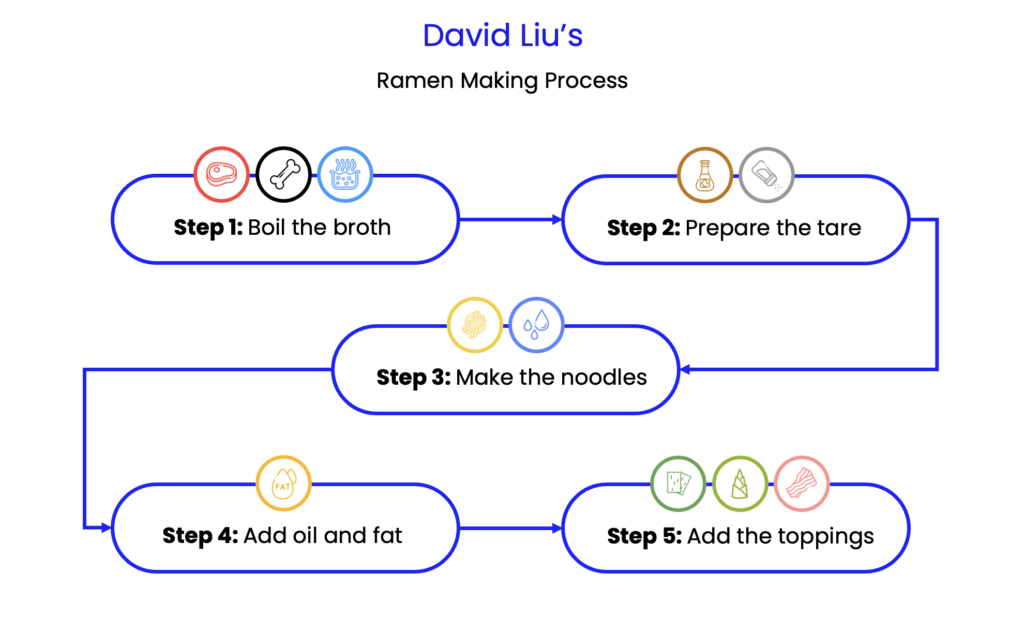
David Liu’s Ramen Making Process
“Ramen is my go-to favorite, and exploring great ramen spots in downtown Toronto has been so much fun. Now, a quick heads-up—I’m not a pro chef, just a big ramen fan who enjoys watching ramen videos online.
So, here’s how you make it. First off, you start with making the broth. Boil stuff like bones, meat, and extra flavors to get a yummy base for your ramen.
Then comes the Tare, which is the seasoning. It’s usually made with soy sauce, salt, or miso. You mix it into the broth to amp up the flavor.
Next is making the noodles. Mix flour with water (sometimes carbonated water), stretch the dough, and cut it into noodles.
To make the broth richer, add some fats and oils. It gives the ramen that extra deliciousness.
Finally, to make it look cool and taste even better, add toppings like pork, seaweed, bamboo shoots on top of the noodles and broth. It’s like the cherry on top, making your ramen not just tasty but also a feast for the eyes.”
Feeling inspired by David’s journey? Want to supercharge your own business processes? Whether you’re craving insights on enhancing workflows or simply curious about David’s favorite ramen spots, he’s your go-to person! Reach out to David at davidl@blanclabs.com.
Lenders Transformation Playbook: Bridging Strategy and Execution
AI’s Mid-Market Makeover in Financial Services

Mid-sized financial services institutions (FIs) are facing significant challenges during this period of rapid technological change, particularly with the rise of artificial intelligence (AI). As customer expectations grow, smaller banks and lenders must stay competitive and responsive. Canada’s largest financial institutions are already advancing in AI, while many others remain in ‘observer’ mode, hesitant to invest and experiment. Yet, mid-sized FIs that adopt the right strategy have unique agility, allowing them to adapt swiftly and efficiently to technological disruptions—even more so than their larger counterparts.
Process Improvement and Automation Support the Mission at Trez Capital 🚀

Trez distributes capital based on very specific criteria. But with over 300 investments in their portfolio, they process numerous payment requests and deal with documents in varied data formats. They saw an opportunity to enhance efficiency, improve task management, and better utilize data insights for strategic decision-making.
Align, Assemble, Assure: A Framework for AI Adoption

An in-depth guide for adopting and scaling AI in the enterprise using actionable and measurable steps.
Blanc Labs Welcomes Two New Leaders to Advance AI Innovation and Enhance Tech Advisory Services for Financial Institutions Across North America

Blanc Labs and TCG Process have partnered to transform lending operations with innovative automation solutions, using the DocProStar platform to enhance efficiency, compliance, and customer satisfaction in the Canadian lending market.
Blanc Labs Partners with TCG Process to Integrate their Automation and Orchestration Platform and deliver Advanced Intelligent Workflow Automation to Financial Institutions

Blanc Labs and TCG Process have partnered to transform lending operations with innovative automation solutions, using the DocProStar platform to enhance efficiency, compliance, and customer satisfaction in the Canadian lending market.
BPI in Banking and Financial Services in the US & Canada

Banking and financial services are changing fast. Moving from old, paper methods to new, digital ones is key to staying in business. It’s important to think about how business process improvement (BPI) can help.
Business Process Improvement vs Business Process Reengineering

Business process improvement vs. reengineering is a tough choice. In this guide, we help you choose between the two based on four factors.
What is the role of a Business Process Improvement Specialist?

A business process improvement specialist identifies bottlenecks and inefficiencies in your workflows, allowing you to focus efforts on automating the right processes.
Open Banking Technology Architecture Whitepaper

We’ve developed this resource to help technical teams adopt an Open Banking approach by explaining a high-level solution architecture that is organization agnostic.
Winning the Open Banking Race: A Challenger’s Path to Entering the Ecosystem Economy

Learn about the steps you can take in forming an open banking strategy and executing on it.
Canadian IT services firms offer a strategic opportunity for US Banks and FIs

Discover the strategic advantage for U.S. banks embracing innovation with cost-effective Canadian nearshore IT support.
These are not your grandmother’s models: the impact of LLM’s on Document Processing

Explore the transformative influence of large language models (LLMs) on document processing in this insightful article. Discover how these cutting-edge models are reshaping traditional approaches, unlocking new possibilities in data analysis, and revolutionizing the way we interact with information.
From Chaos to Clarity: Achieving Operational Excellence through Business Process Improvement

Discover transformative insights and strategies to streamline operations, enhance efficiency, and drive success.
Banking Automation: The Complete Guide
thirdstream and Blanc Labs collaborating to bring intelligent document processing to financial institutions
Challenges in Digital Lending
Lenders Transformation Playbook: Bridging Strategy and Execution
AI’s Mid-Market Makeover in Financial Services

Mid-sized financial services institutions (FIs) are facing significant challenges during this period of rapid technological change, particularly with the rise of artificial intelligence (AI). As customer expectations grow, smaller banks and lenders must stay competitive and responsive. Canada’s largest financial institutions are already advancing in AI, while many others remain in ‘observer’ mode, hesitant to invest and experiment. Yet, mid-sized FIs that adopt the right strategy have unique agility, allowing them to adapt swiftly and efficiently to technological disruptions—even more so than their larger counterparts.
Process Improvement and Automation Support the Mission at Trez Capital 🚀

Trez distributes capital based on very specific criteria. But with over 300 investments in their portfolio, they process numerous payment requests and deal with documents in varied data formats. They saw an opportunity to enhance efficiency, improve task management, and better utilize data insights for strategic decision-making.
Align, Assemble, Assure: A Framework for AI Adoption

An in-depth guide for adopting and scaling AI in the enterprise using actionable and measurable steps.
Blanc Labs Welcomes Two New Leaders to Advance AI Innovation and Enhance Tech Advisory Services for Financial Institutions Across North America

Blanc Labs and TCG Process have partnered to transform lending operations with innovative automation solutions, using the DocProStar platform to enhance efficiency, compliance, and customer satisfaction in the Canadian lending market.
Blanc Labs Partners with TCG Process to Integrate their Automation and Orchestration Platform and deliver Advanced Intelligent Workflow Automation to Financial Institutions

Blanc Labs and TCG Process have partnered to transform lending operations with innovative automation solutions, using the DocProStar platform to enhance efficiency, compliance, and customer satisfaction in the Canadian lending market.
BPI in Banking and Financial Services in the US & Canada

Banking and financial services are changing fast. Moving from old, paper methods to new, digital ones is key to staying in business. It’s important to think about how business process improvement (BPI) can help.
Business Process Improvement vs Business Process Reengineering

Business process improvement vs. reengineering is a tough choice. In this guide, we help you choose between the two based on four factors.
What is the role of a Business Process Improvement Specialist?

A business process improvement specialist identifies bottlenecks and inefficiencies in your workflows, allowing you to focus efforts on automating the right processes.
Open Banking Technology Architecture Whitepaper

We’ve developed this resource to help technical teams adopt an Open Banking approach by explaining a high-level solution architecture that is organization agnostic.
Winning the Open Banking Race: A Challenger’s Path to Entering the Ecosystem Economy

Learn about the steps you can take in forming an open banking strategy and executing on it.
Canadian IT services firms offer a strategic opportunity for US Banks and FIs

Discover the strategic advantage for U.S. banks embracing innovation with cost-effective Canadian nearshore IT support.
These are not your grandmother’s models: the impact of LLM’s on Document Processing

Explore the transformative influence of large language models (LLMs) on document processing in this insightful article. Discover how these cutting-edge models are reshaping traditional approaches, unlocking new possibilities in data analysis, and revolutionizing the way we interact with information.
From Chaos to Clarity: Achieving Operational Excellence through Business Process Improvement

Discover transformative insights and strategies to streamline operations, enhance efficiency, and drive success.
Banking Automation: The Complete Guide
thirdstream and Blanc Labs collaborating to bring intelligent document processing to financial institutions
Challenges in Digital Lending
Lenders Transformation Playbook: Bridging Strategy and Execution
AI’s Mid-Market Makeover in Financial Services

Mid-sized financial services institutions (FIs) are facing significant challenges during this period of rapid technological change, particularly with the rise of artificial intelligence (AI). As customer expectations grow, smaller banks and lenders must stay competitive and responsive. Canada’s largest financial institutions are already advancing in AI, while many others remain in ‘observer’ mode, hesitant to invest and experiment. Yet, mid-sized FIs that adopt the right strategy have unique agility, allowing them to adapt swiftly and efficiently to technological disruptions—even more so than their larger counterparts.
Process Improvement and Automation Support the Mission at Trez Capital 🚀

Trez distributes capital based on very specific criteria. But with over 300 investments in their portfolio, they process numerous payment requests and deal with documents in varied data formats. They saw an opportunity to enhance efficiency, improve task management, and better utilize data insights for strategic decision-making.
Align, Assemble, Assure: A Framework for AI Adoption

An in-depth guide for adopting and scaling AI in the enterprise using actionable and measurable steps.
Blanc Labs Welcomes Two New Leaders to Advance AI Innovation and Enhance Tech Advisory Services for Financial Institutions Across North America

Blanc Labs and TCG Process have partnered to transform lending operations with innovative automation solutions, using the DocProStar platform to enhance efficiency, compliance, and customer satisfaction in the Canadian lending market.
Blanc Labs Partners with TCG Process to Integrate their Automation and Orchestration Platform and deliver Advanced Intelligent Workflow Automation to Financial Institutions

Blanc Labs and TCG Process have partnered to transform lending operations with innovative automation solutions, using the DocProStar platform to enhance efficiency, compliance, and customer satisfaction in the Canadian lending market.
BPI in Banking and Financial Services in the US & Canada

Banking and financial services are changing fast. Moving from old, paper methods to new, digital ones is key to staying in business. It’s important to think about how business process improvement (BPI) can help.
Business Process Improvement vs Business Process Reengineering

Business process improvement vs. reengineering is a tough choice. In this guide, we help you choose between the two based on four factors.
What is the role of a Business Process Improvement Specialist?

A business process improvement specialist identifies bottlenecks and inefficiencies in your workflows, allowing you to focus efforts on automating the right processes.
Open Banking Technology Architecture Whitepaper

We’ve developed this resource to help technical teams adopt an Open Banking approach by explaining a high-level solution architecture that is organization agnostic.
Winning the Open Banking Race: A Challenger’s Path to Entering the Ecosystem Economy

Learn about the steps you can take in forming an open banking strategy and executing on it.
Canadian IT services firms offer a strategic opportunity for US Banks and FIs

Discover the strategic advantage for U.S. banks embracing innovation with cost-effective Canadian nearshore IT support.
These are not your grandmother’s models: the impact of LLM’s on Document Processing

Explore the transformative influence of large language models (LLMs) on document processing in this insightful article. Discover how these cutting-edge models are reshaping traditional approaches, unlocking new possibilities in data analysis, and revolutionizing the way we interact with information.
From Chaos to Clarity: Achieving Operational Excellence through Business Process Improvement

Discover transformative insights and strategies to streamline operations, enhance efficiency, and drive success.
Banking Automation: The Complete Guide
thirdstream and Blanc Labs collaborating to bring intelligent document processing to financial institutions
Challenges in Digital Lending
2023 Fall Economic Update on Consumer-Driven Banking 🥳
2023 Fall Economic Update on Consumer-Driven Banking 🥳
November 29, 2023When we attended the CLA Lenders Summit a few weeks ago, it seemed like everyone was ready to sign the death certificate for Open Banking in Canada. Very little, if any, material progress had been communicated on behalf of the government to create a regulatory framework or policy mandate to make good on the promise or timelines defined by an Advisory Committee on Open Banking Report which became the mandate of Abraham Tachjian, who was appointed as Canada’s Open Banking lead, by the Liberal government in 2022.
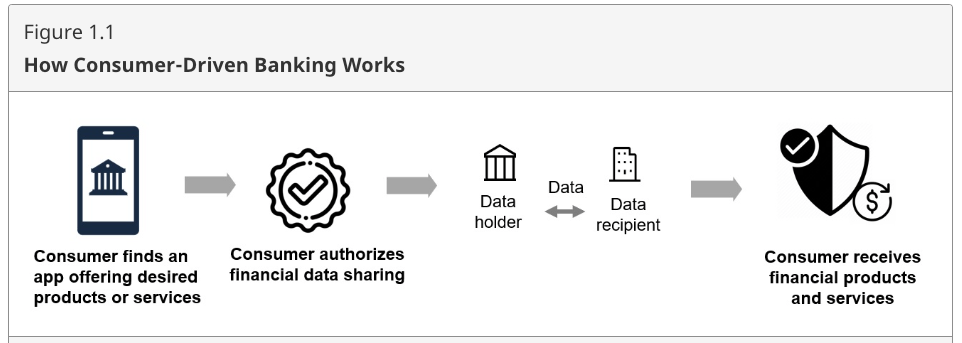
Aside from a snazzy rebrand of the open banking moniker, the policy statement on Consumer-Driven Banking outlined the goal of “adopting legislation and fully implementing the necessary governance framework by 2025”. It would seem from the update, part of the government’s motivation for moving ahead with consumer-driven banking is a focus on the affordability crises facing many Canadians. The Consumer-Driven Banking policy statement was listed under the header of “Making Life More Affordable” in the economic update. The update for Canada now seems to be following a similar path to how policy is being shaped and implemented in the US.
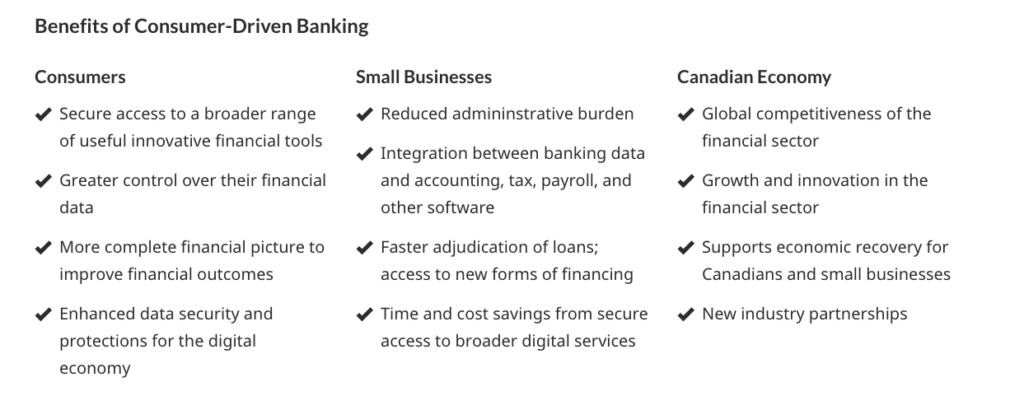
Our Take:
As long-term believers in the benefits of Open Banking, we are thrilled to learn of the renewed commitment to making consumer-directed banking a reality in Canada. While there is still a lot of work to be done as well as the additional hurdle of new legislation being tabled during an election cycle, we are committed to the potential benefits of Consumer Directed Banking for banking customers and the significant opportunity for innovation and collaboration in the Canadian financial services sector.
You can read the full Fall Economic Statement here but if you are short on time, ChatGPT did a pretty good job of summarizing the statement in bullets, below.
Introduction to Consumer-Driven Banking:
-
- Allows secure transfer of financial data via API.
- Aims to replace unsecure screen-scraping.
- Enables access to data-driven financial services.
Benefits of Consumer-driven Banking:
-
- Consumers gain secure access to innovative financial tools.
- Greater control over financial data for improved outcomes.
- Small businesses experience reduced administrative burden.
Policy Objectives:
-
- Safety and soundness of the financial sector.
- Consumer financial well-being and protection.
- Economic growth and international competitiveness.
Core Framework Elements:
-
- Governance: Oversight and management of the system.
- Scope: Types of data, participants, and expansion pace.
- Accreditation: Requirements for participating in data sharing.
- Common Rules: Privacy, security, and liability guidelines.
- Technical Standards: Establishment and oversight of data flow.
Course of Action (Legislation in 2024):
-
- Phased approach to scope, oversight, and screen-scraping elimination.
- Key elements codified in legislation.
- Mandate to a government-led entity for supervision and enforcement.
Governance (Effective Oversight):
-
- Government-led entity to supervise and enforce the framework.
- Model for provincial entities to “opt-in” to governance.
- Strong governance framework to ensure compliance.
Scope (Phased Implementation):
-
- Initial phase includes federally-regulated financial institutions.
- Opt-in option for credit unions and third parties.
- Reciprocal access for all entities to promote data portability.
Accreditation (Trusted Data Sharing):
-
- Formal framework for entities collecting consumer data.
- Regular reporting for accreditation maintenance.
- Exemption for federally-regulated banks and credit unions.
Common Rules (Transparent Foundation):
-
- Privacy, security, and liability obligations.
- Compliance as a condition for data access.
- Complements existing legislation.
Privacy (Protection Measures):
-
- Participants must comply with legislative frameworks.
- Specific privacy rules for financial data sharing.
- Consent dashboards for real-time consumer control.
Liability (Clear Structure):
-
- Statutory contractual relationship between participants.
- Liability moves with the data and rests with the party at fault.
- Internal policies and procedures for complaint handling.
Security (Protecting Consumer Data):
-
- Clear security requirements for accredited entities.
- Oversight of security standards in legislation.
- Ongoing reporting obligations for data protection.
Single Technical Standard:
-
- Mandate for a single technical standard.
- Legislation to outline principles and oversight.
Next Steps for consumer-driven banking:
-
- Department of Finance aims to implement the framework by 2025.
- Ongoing engagement with industry stakeholders.
- Legislative framework development and phased implementation.
Related Insights
Lenders Transformation Playbook: Bridging Strategy and Execution
AI’s Mid-Market Makeover in Financial Services

Mid-sized financial services institutions (FIs) are facing significant challenges during this period of rapid technological change, particularly with the rise of artificial intelligence (AI). As customer expectations grow, smaller banks and lenders must stay competitive and responsive. Canada’s largest financial institutions are already advancing in AI, while many others remain in ‘observer’ mode, hesitant to invest and experiment. Yet, mid-sized FIs that adopt the right strategy have unique agility, allowing them to adapt swiftly and efficiently to technological disruptions—even more so than their larger counterparts.
Process Improvement and Automation Support the Mission at Trez Capital 🚀

Trez distributes capital based on very specific criteria. But with over 300 investments in their portfolio, they process numerous payment requests and deal with documents in varied data formats. They saw an opportunity to enhance efficiency, improve task management, and better utilize data insights for strategic decision-making.
Align, Assemble, Assure: A Framework for AI Adoption

An in-depth guide for adopting and scaling AI in the enterprise using actionable and measurable steps.
Blanc Labs Welcomes Two New Leaders to Advance AI Innovation and Enhance Tech Advisory Services for Financial Institutions Across North America

Blanc Labs and TCG Process have partnered to transform lending operations with innovative automation solutions, using the DocProStar platform to enhance efficiency, compliance, and customer satisfaction in the Canadian lending market.
Blanc Labs Partners with TCG Process to Integrate their Automation and Orchestration Platform and deliver Advanced Intelligent Workflow Automation to Financial Institutions

Blanc Labs and TCG Process have partnered to transform lending operations with innovative automation solutions, using the DocProStar platform to enhance efficiency, compliance, and customer satisfaction in the Canadian lending market.
BPI in Banking and Financial Services in the US & Canada

Banking and financial services are changing fast. Moving from old, paper methods to new, digital ones is key to staying in business. It’s important to think about how business process improvement (BPI) can help.
Business Process Improvement vs Business Process Reengineering

Business process improvement vs. reengineering is a tough choice. In this guide, we help you choose between the two based on four factors.
What is the role of a Business Process Improvement Specialist?

A business process improvement specialist identifies bottlenecks and inefficiencies in your workflows, allowing you to focus efforts on automating the right processes.
Open Banking Technology Architecture Whitepaper

We’ve developed this resource to help technical teams adopt an Open Banking approach by explaining a high-level solution architecture that is organization agnostic.
Winning the Open Banking Race: A Challenger’s Path to Entering the Ecosystem Economy

Learn about the steps you can take in forming an open banking strategy and executing on it.
Canadian IT services firms offer a strategic opportunity for US Banks and FIs

Discover the strategic advantage for U.S. banks embracing innovation with cost-effective Canadian nearshore IT support.
These are not your grandmother’s models: the impact of LLM’s on Document Processing

Explore the transformative influence of large language models (LLMs) on document processing in this insightful article. Discover how these cutting-edge models are reshaping traditional approaches, unlocking new possibilities in data analysis, and revolutionizing the way we interact with information.
From Chaos to Clarity: Achieving Operational Excellence through Business Process Improvement

Discover transformative insights and strategies to streamline operations, enhance efficiency, and drive success.
5 Benefits of Open Banking APIs
Blanc Labs and Axway partner up to provide integrated open banking solutions for all
5 Factors to Evaluate Open Banking Readiness in Canada
4 Ways APIs Can Improve Your Bank
Lenders Transformation Playbook: Bridging Strategy and Execution
AI’s Mid-Market Makeover in Financial Services

Mid-sized financial services institutions (FIs) are facing significant challenges during this period of rapid technological change, particularly with the rise of artificial intelligence (AI). As customer expectations grow, smaller banks and lenders must stay competitive and responsive. Canada’s largest financial institutions are already advancing in AI, while many others remain in ‘observer’ mode, hesitant to invest and experiment. Yet, mid-sized FIs that adopt the right strategy have unique agility, allowing them to adapt swiftly and efficiently to technological disruptions—even more so than their larger counterparts.
Process Improvement and Automation Support the Mission at Trez Capital 🚀

Trez distributes capital based on very specific criteria. But with over 300 investments in their portfolio, they process numerous payment requests and deal with documents in varied data formats. They saw an opportunity to enhance efficiency, improve task management, and better utilize data insights for strategic decision-making.
Align, Assemble, Assure: A Framework for AI Adoption

An in-depth guide for adopting and scaling AI in the enterprise using actionable and measurable steps.
Blanc Labs Welcomes Two New Leaders to Advance AI Innovation and Enhance Tech Advisory Services for Financial Institutions Across North America

Blanc Labs and TCG Process have partnered to transform lending operations with innovative automation solutions, using the DocProStar platform to enhance efficiency, compliance, and customer satisfaction in the Canadian lending market.
Blanc Labs Partners with TCG Process to Integrate their Automation and Orchestration Platform and deliver Advanced Intelligent Workflow Automation to Financial Institutions

Blanc Labs and TCG Process have partnered to transform lending operations with innovative automation solutions, using the DocProStar platform to enhance efficiency, compliance, and customer satisfaction in the Canadian lending market.
BPI in Banking and Financial Services in the US & Canada

Banking and financial services are changing fast. Moving from old, paper methods to new, digital ones is key to staying in business. It’s important to think about how business process improvement (BPI) can help.
Business Process Improvement vs Business Process Reengineering

Business process improvement vs. reengineering is a tough choice. In this guide, we help you choose between the two based on four factors.
What is the role of a Business Process Improvement Specialist?

A business process improvement specialist identifies bottlenecks and inefficiencies in your workflows, allowing you to focus efforts on automating the right processes.
Open Banking Technology Architecture Whitepaper

We’ve developed this resource to help technical teams adopt an Open Banking approach by explaining a high-level solution architecture that is organization agnostic.
Winning the Open Banking Race: A Challenger’s Path to Entering the Ecosystem Economy

Learn about the steps you can take in forming an open banking strategy and executing on it.
Canadian IT services firms offer a strategic opportunity for US Banks and FIs

Discover the strategic advantage for U.S. banks embracing innovation with cost-effective Canadian nearshore IT support.
These are not your grandmother’s models: the impact of LLM’s on Document Processing

Explore the transformative influence of large language models (LLMs) on document processing in this insightful article. Discover how these cutting-edge models are reshaping traditional approaches, unlocking new possibilities in data analysis, and revolutionizing the way we interact with information.
From Chaos to Clarity: Achieving Operational Excellence through Business Process Improvement

Discover transformative insights and strategies to streamline operations, enhance efficiency, and drive success.
5 Benefits of Open Banking APIs
Blanc Labs and Axway partner up to provide integrated open banking solutions for all
5 Factors to Evaluate Open Banking Readiness in Canada
4 Ways APIs Can Improve Your Bank
Lenders Transformation Playbook: Bridging Strategy and Execution
AI’s Mid-Market Makeover in Financial Services

Mid-sized financial services institutions (FIs) are facing significant challenges during this period of rapid technological change, particularly with the rise of artificial intelligence (AI). As customer expectations grow, smaller banks and lenders must stay competitive and responsive. Canada’s largest financial institutions are already advancing in AI, while many others remain in ‘observer’ mode, hesitant to invest and experiment. Yet, mid-sized FIs that adopt the right strategy have unique agility, allowing them to adapt swiftly and efficiently to technological disruptions—even more so than their larger counterparts.
Process Improvement and Automation Support the Mission at Trez Capital 🚀

Trez distributes capital based on very specific criteria. But with over 300 investments in their portfolio, they process numerous payment requests and deal with documents in varied data formats. They saw an opportunity to enhance efficiency, improve task management, and better utilize data insights for strategic decision-making.
Align, Assemble, Assure: A Framework for AI Adoption

An in-depth guide for adopting and scaling AI in the enterprise using actionable and measurable steps.
Blanc Labs Welcomes Two New Leaders to Advance AI Innovation and Enhance Tech Advisory Services for Financial Institutions Across North America

Blanc Labs and TCG Process have partnered to transform lending operations with innovative automation solutions, using the DocProStar platform to enhance efficiency, compliance, and customer satisfaction in the Canadian lending market.
Blanc Labs Partners with TCG Process to Integrate their Automation and Orchestration Platform and deliver Advanced Intelligent Workflow Automation to Financial Institutions

Blanc Labs and TCG Process have partnered to transform lending operations with innovative automation solutions, using the DocProStar platform to enhance efficiency, compliance, and customer satisfaction in the Canadian lending market.
BPI in Banking and Financial Services in the US & Canada

Banking and financial services are changing fast. Moving from old, paper methods to new, digital ones is key to staying in business. It’s important to think about how business process improvement (BPI) can help.
Business Process Improvement vs Business Process Reengineering

Business process improvement vs. reengineering is a tough choice. In this guide, we help you choose between the two based on four factors.
What is the role of a Business Process Improvement Specialist?

A business process improvement specialist identifies bottlenecks and inefficiencies in your workflows, allowing you to focus efforts on automating the right processes.
Open Banking Technology Architecture Whitepaper

We’ve developed this resource to help technical teams adopt an Open Banking approach by explaining a high-level solution architecture that is organization agnostic.
Winning the Open Banking Race: A Challenger’s Path to Entering the Ecosystem Economy

Learn about the steps you can take in forming an open banking strategy and executing on it.
Canadian IT services firms offer a strategic opportunity for US Banks and FIs

Discover the strategic advantage for U.S. banks embracing innovation with cost-effective Canadian nearshore IT support.
These are not your grandmother’s models: the impact of LLM’s on Document Processing

Explore the transformative influence of large language models (LLMs) on document processing in this insightful article. Discover how these cutting-edge models are reshaping traditional approaches, unlocking new possibilities in data analysis, and revolutionizing the way we interact with information.
From Chaos to Clarity: Achieving Operational Excellence through Business Process Improvement

Discover transformative insights and strategies to streamline operations, enhance efficiency, and drive success.
5 Benefits of Open Banking APIs
Blanc Labs and Axway partner up to provide integrated open banking solutions for all
5 Factors to Evaluate Open Banking Readiness in Canada
4 Ways APIs Can Improve Your Bank
The Keys to the Secret Garden: Unlocking the Potential of AI in the Enterprise
The Keys to the Secret Garden: Unlocking the Potential of AI in the Enterprise
November 27, 2023
At this point, enterprise generative AI applications for software development, marketing, customer/employee service , and product design are proliferating as the standout use-cases early adopters are focusing on. From our position working with clients to develop and enable enterprise data + AI solutions, we’ve gained perspective on several of the foundational characteristics enterprises will need to develop to realize on the promise of this 3rd wave of the human-computer revolution.
But First, a Disclaimer
Blanc Labs focuses on the financial services and healthcare industries. We see both sectors as having massive potential in terms of the benefits offered through the application of these transformative technologies. Both healthcare and financial services are hugely complex, highly regulated, and depending on who you speak to, resistant to change. We believe the stage is set for a broader divergence of winners and losers: organizations that build capability and competency in adopting new tools and leverage the power of their enterprise data will stand to reap the benefits of their investments.
⛔️ Cloud Infrastructure Only ⛔️
Enterprise Platforms are a Lynchpin
If we consider that having completed a cloud migration or cloud native approach is table stakes for AI enablement within an organization, the next big question will be where your enterprise data resides. The organization’s technology infrastructure and enterprise platform ecosystem will in many ways determine what toolsets may be available to facilitate experimentation and development of AI enabled use cases.
If you are a CIO, CTO or CDO, start by taking stock of the platforms that house your enterprise data and evaluate the toolsets offered by these power technology-ecosystem juggernauts. Microsoft and AWS are emerging as clear leaders in terms of providing their customers powerful tools to apply ML and AI to their enterprise data, but Salesforce, SAP, Pega and OpenText – amongst many others will offer tooling to access, manage and apply AI to enterprise data.
It is impossible to predict who the big winners and losers of this space will be, partially because they are such massive and well entrenched players but keep an eye on this space over the next few years.
The 👿 is in the Data [Taxonomy]
Building an enterprise data model across a complicated operating environment like a bank is no small feat. Standardizing data definitions between different lines of business in a bank involves tackling the complexity of enterprise (+legacy) platforms used to store and handle data. This complexity extends to accommodating the diverse needs of various stakeholder groups with distinct preferences for accessing, manipulating, and analyzing data.
In many ways, risk is a unifying theme and responsibility within regulated industries like the banking sector. We see conformance to risk measurement and regulatory reporting requirements as a lightning rod for action amongst FI’s to get their “data house” in order but proactive approaches amongst banking and technology executives are few and far between.
In a recent interview with Tech Exec magazine, VP of Data and Adaptive Intelligence at Munich Re Canada Branch (Life), Lovell Hodge encapsulated the shift in how progressive organizations are thinking about their data:
“Over the years, there has been a realization that data has an inherent information value to the organization. As the years go by, we’re rapidly producing more data at an increasingly and somewhat alarming rate. So, what a lot of folks in the industry have realized is that there is not a huge space between theoretical concepts around information from data, and how they can use that information to simplify internal processes and also benefit clients.
So, you’re seeing that interdependence starting to mature. And because of that, many organizations are looking at their data not as just something they have to store, but as an asset they can leverage. And once you start thinking in that sort of way, then you start to formulate methods by which you can gain value from data, and it becomes an important part of your corporate strategy.”
App Design and Development Now Occurs ‘In the Data’
Historically, software design and development occurred in a sandbox that was devoid of enterprise data. In traditional dev environments we piped in dummy data to test parameters and during QA tested connectivity and security. But with the explosion of sophisticated ML and AI tools, application development will very much occur at the nexus of querying, manipulating, analyzing and visualizing proprietary data sets.
There is a tremendous amount of opportunity for these new tools to democratize data for business users through the use of conversational/natural language query tools to conduct analysis and derive insights from enterprise data sets.
Another big change will be the blurring of the lines between the role of developers and data scientists and in many cases, these resources will be working directly alongside each other. Technical resources will require access to live data sets to facilitate model training and to leverage powerful data analytics toolsets. This is going to require a significant shift (from reactive to proactive) in terms of access management and data security.
Firms that work with external partners will require them to adhere to an extremely high standard of data security protocols i.e., ISO and SOC 2 compliance certification with regular audits.
Specific sector, domain, and knowledge of business context has always counted for a lot but increasingly developers won’t be able to rely on detailed functional, technical and design requirements documentation to define the specs of what they are developing. It will require a much more experimental, test and learn approach. Toolsets are only going to get more user friendly to work with but developing high impact apps leveraging advanced AI/ML techniques will require a detailed and nuanced understanding of user needs, workflow, data inputs, command prompts, prompt modelling strategies, and a continuous improvement approach to get to a place of lasting and tangible impact for businesses and teams.
In Summary:
There is much still to be learned through this large-scale adoption of a suite of technologies that are evolving at such a rapid pace. This is by no means a complete list of the things business teams and leaders need to consider as they look to capture competitive advantage from these powerful new tools. At Blanc Labs, we are excited about the future and look forward to working with companies to develop their capabilities to create business value by harnessing the tremendous potential of their enterprise data.
About the Author

With over 15 years in technology consulting services, I am thrilled at how next-gen technologies will unlock a new wave of innovation and productivity for enterprises.
Related Insights
Lenders Transformation Playbook: Bridging Strategy and Execution
AI’s Mid-Market Makeover in Financial Services

Mid-sized financial services institutions (FIs) are facing significant challenges during this period of rapid technological change, particularly with the rise of artificial intelligence (AI). As customer expectations grow, smaller banks and lenders must stay competitive and responsive. Canada’s largest financial institutions are already advancing in AI, while many others remain in ‘observer’ mode, hesitant to invest and experiment. Yet, mid-sized FIs that adopt the right strategy have unique agility, allowing them to adapt swiftly and efficiently to technological disruptions—even more so than their larger counterparts.
Process Improvement and Automation Support the Mission at Trez Capital 🚀

Trez distributes capital based on very specific criteria. But with over 300 investments in their portfolio, they process numerous payment requests and deal with documents in varied data formats. They saw an opportunity to enhance efficiency, improve task management, and better utilize data insights for strategic decision-making.
Align, Assemble, Assure: A Framework for AI Adoption

An in-depth guide for adopting and scaling AI in the enterprise using actionable and measurable steps.
Blanc Labs Welcomes Two New Leaders to Advance AI Innovation and Enhance Tech Advisory Services for Financial Institutions Across North America

Blanc Labs and TCG Process have partnered to transform lending operations with innovative automation solutions, using the DocProStar platform to enhance efficiency, compliance, and customer satisfaction in the Canadian lending market.
Blanc Labs Partners with TCG Process to Integrate their Automation and Orchestration Platform and deliver Advanced Intelligent Workflow Automation to Financial Institutions

Blanc Labs and TCG Process have partnered to transform lending operations with innovative automation solutions, using the DocProStar platform to enhance efficiency, compliance, and customer satisfaction in the Canadian lending market.
BPI in Banking and Financial Services in the US & Canada

Banking and financial services are changing fast. Moving from old, paper methods to new, digital ones is key to staying in business. It’s important to think about how business process improvement (BPI) can help.
Business Process Improvement vs Business Process Reengineering

Business process improvement vs. reengineering is a tough choice. In this guide, we help you choose between the two based on four factors.
What is the role of a Business Process Improvement Specialist?

A business process improvement specialist identifies bottlenecks and inefficiencies in your workflows, allowing you to focus efforts on automating the right processes.
Open Banking Technology Architecture Whitepaper

We’ve developed this resource to help technical teams adopt an Open Banking approach by explaining a high-level solution architecture that is organization agnostic.
Winning the Open Banking Race: A Challenger’s Path to Entering the Ecosystem Economy

Learn about the steps you can take in forming an open banking strategy and executing on it.
Canadian IT services firms offer a strategic opportunity for US Banks and FIs

Discover the strategic advantage for U.S. banks embracing innovation with cost-effective Canadian nearshore IT support.
These are not your grandmother’s models: the impact of LLM’s on Document Processing

Explore the transformative influence of large language models (LLMs) on document processing in this insightful article. Discover how these cutting-edge models are reshaping traditional approaches, unlocking new possibilities in data analysis, and revolutionizing the way we interact with information.
From Chaos to Clarity: Achieving Operational Excellence through Business Process Improvement

Discover transformative insights and strategies to streamline operations, enhance efficiency, and drive success.
Low-Code Tools and Automation Power Minor Ailments Program for Pharmacists

Blanc Labs teamed up with Daylight Automation (acquired by Quadient) to overhaul the process pharmacists use to assess and treat minor ailments, at a critical inflection point for Canadians to efficiently access healthcare services.
Banking Automation: The Complete Guide
Three Reasons Financial Institutions Are Losing Out to FinTechs
Lenders Transformation Playbook: Bridging Strategy and Execution
AI’s Mid-Market Makeover in Financial Services

Mid-sized financial services institutions (FIs) are facing significant challenges during this period of rapid technological change, particularly with the rise of artificial intelligence (AI). As customer expectations grow, smaller banks and lenders must stay competitive and responsive. Canada’s largest financial institutions are already advancing in AI, while many others remain in ‘observer’ mode, hesitant to invest and experiment. Yet, mid-sized FIs that adopt the right strategy have unique agility, allowing them to adapt swiftly and efficiently to technological disruptions—even more so than their larger counterparts.
Process Improvement and Automation Support the Mission at Trez Capital 🚀

Trez distributes capital based on very specific criteria. But with over 300 investments in their portfolio, they process numerous payment requests and deal with documents in varied data formats. They saw an opportunity to enhance efficiency, improve task management, and better utilize data insights for strategic decision-making.
Align, Assemble, Assure: A Framework for AI Adoption

An in-depth guide for adopting and scaling AI in the enterprise using actionable and measurable steps.
Blanc Labs Welcomes Two New Leaders to Advance AI Innovation and Enhance Tech Advisory Services for Financial Institutions Across North America

Blanc Labs and TCG Process have partnered to transform lending operations with innovative automation solutions, using the DocProStar platform to enhance efficiency, compliance, and customer satisfaction in the Canadian lending market.
Blanc Labs Partners with TCG Process to Integrate their Automation and Orchestration Platform and deliver Advanced Intelligent Workflow Automation to Financial Institutions

Blanc Labs and TCG Process have partnered to transform lending operations with innovative automation solutions, using the DocProStar platform to enhance efficiency, compliance, and customer satisfaction in the Canadian lending market.
BPI in Banking and Financial Services in the US & Canada

Banking and financial services are changing fast. Moving from old, paper methods to new, digital ones is key to staying in business. It’s important to think about how business process improvement (BPI) can help.
Business Process Improvement vs Business Process Reengineering

Business process improvement vs. reengineering is a tough choice. In this guide, we help you choose between the two based on four factors.
What is the role of a Business Process Improvement Specialist?

A business process improvement specialist identifies bottlenecks and inefficiencies in your workflows, allowing you to focus efforts on automating the right processes.
Open Banking Technology Architecture Whitepaper

We’ve developed this resource to help technical teams adopt an Open Banking approach by explaining a high-level solution architecture that is organization agnostic.
Winning the Open Banking Race: A Challenger’s Path to Entering the Ecosystem Economy

Learn about the steps you can take in forming an open banking strategy and executing on it.
Canadian IT services firms offer a strategic opportunity for US Banks and FIs

Discover the strategic advantage for U.S. banks embracing innovation with cost-effective Canadian nearshore IT support.
These are not your grandmother’s models: the impact of LLM’s on Document Processing

Explore the transformative influence of large language models (LLMs) on document processing in this insightful article. Discover how these cutting-edge models are reshaping traditional approaches, unlocking new possibilities in data analysis, and revolutionizing the way we interact with information.
From Chaos to Clarity: Achieving Operational Excellence through Business Process Improvement

Discover transformative insights and strategies to streamline operations, enhance efficiency, and drive success.
Low-Code Tools and Automation Power Minor Ailments Program for Pharmacists

Blanc Labs teamed up with Daylight Automation (acquired by Quadient) to overhaul the process pharmacists use to assess and treat minor ailments, at a critical inflection point for Canadians to efficiently access healthcare services.
Banking Automation: The Complete Guide
Three Reasons Financial Institutions Are Losing Out to FinTechs
Lenders Transformation Playbook: Bridging Strategy and Execution
AI’s Mid-Market Makeover in Financial Services

Mid-sized financial services institutions (FIs) are facing significant challenges during this period of rapid technological change, particularly with the rise of artificial intelligence (AI). As customer expectations grow, smaller banks and lenders must stay competitive and responsive. Canada’s largest financial institutions are already advancing in AI, while many others remain in ‘observer’ mode, hesitant to invest and experiment. Yet, mid-sized FIs that adopt the right strategy have unique agility, allowing them to adapt swiftly and efficiently to technological disruptions—even more so than their larger counterparts.
Process Improvement and Automation Support the Mission at Trez Capital 🚀

Trez distributes capital based on very specific criteria. But with over 300 investments in their portfolio, they process numerous payment requests and deal with documents in varied data formats. They saw an opportunity to enhance efficiency, improve task management, and better utilize data insights for strategic decision-making.
Align, Assemble, Assure: A Framework for AI Adoption

An in-depth guide for adopting and scaling AI in the enterprise using actionable and measurable steps.
Blanc Labs Welcomes Two New Leaders to Advance AI Innovation and Enhance Tech Advisory Services for Financial Institutions Across North America

Blanc Labs and TCG Process have partnered to transform lending operations with innovative automation solutions, using the DocProStar platform to enhance efficiency, compliance, and customer satisfaction in the Canadian lending market.
Blanc Labs Partners with TCG Process to Integrate their Automation and Orchestration Platform and deliver Advanced Intelligent Workflow Automation to Financial Institutions

Blanc Labs and TCG Process have partnered to transform lending operations with innovative automation solutions, using the DocProStar platform to enhance efficiency, compliance, and customer satisfaction in the Canadian lending market.
BPI in Banking and Financial Services in the US & Canada

Banking and financial services are changing fast. Moving from old, paper methods to new, digital ones is key to staying in business. It’s important to think about how business process improvement (BPI) can help.
Business Process Improvement vs Business Process Reengineering

Business process improvement vs. reengineering is a tough choice. In this guide, we help you choose between the two based on four factors.
What is the role of a Business Process Improvement Specialist?

A business process improvement specialist identifies bottlenecks and inefficiencies in your workflows, allowing you to focus efforts on automating the right processes.
Open Banking Technology Architecture Whitepaper

We’ve developed this resource to help technical teams adopt an Open Banking approach by explaining a high-level solution architecture that is organization agnostic.
Winning the Open Banking Race: A Challenger’s Path to Entering the Ecosystem Economy

Learn about the steps you can take in forming an open banking strategy and executing on it.
Canadian IT services firms offer a strategic opportunity for US Banks and FIs

Discover the strategic advantage for U.S. banks embracing innovation with cost-effective Canadian nearshore IT support.
These are not your grandmother’s models: the impact of LLM’s on Document Processing

Explore the transformative influence of large language models (LLMs) on document processing in this insightful article. Discover how these cutting-edge models are reshaping traditional approaches, unlocking new possibilities in data analysis, and revolutionizing the way we interact with information.
From Chaos to Clarity: Achieving Operational Excellence through Business Process Improvement

Discover transformative insights and strategies to streamline operations, enhance efficiency, and drive success.
Low-Code Tools and Automation Power Minor Ailments Program for Pharmacists

Blanc Labs teamed up with Daylight Automation (acquired by Quadient) to overhaul the process pharmacists use to assess and treat minor ailments, at a critical inflection point for Canadians to efficiently access healthcare services.
Banking Automation: The Complete Guide
Three Reasons Financial Institutions Are Losing Out to FinTechs
Shannex Adopts Automation to Revolutionize its Employee Experience
Shannex Adopts Automation to Revolutionize its Employee Experience
November 7, 2023
Engagement Summary
Shannex is a leading provider of seniors’ care, service and accommodation across its 47 long-term care and retirement living communities in Nova Scotia, New Brunswick and Ontario.
People are at the core of Shannex’s mission, vision, and values to lead the way to better living for individuals and the communities the company serves.
Like many health care organizations in Canada, Shannex is experiencing an increased demand for health care workers and needed a solution to improve operational effectiveness to bring more employees on board in a more timely and efficient manner.
The employee onboarding process involves multiple departments and is prone to delays, manual errors, and access management challenges. These gaps did not allow new employees timely access to software tools, equipment, and EHR systems. The offboarding workflow, when an employee left or changed roles, also had similar challenges.
Shannex has partnered with Blanc Labs to develop a workflow that leverages Robotic Process Automation (RPA) to improve coordination of task between departments, track onboarding activities and timelines, and manage employee access to new employees or when their role changes.
By partnering with Blanc Labs to map the enterprise workflow across people, processes and technology systems, Shannex expects to see a significant improvement in efficiency and user experience while maintaining system security, leading to higher staff satisfaction and retention rates.
This innovative partnership is being supported by the Coordinated Accessible National (CAN) Health Network – a federally funded organization working to introduce more Canadian technology companies into Canada’s health care system.
Opportunities for Improvement
Shannex’s onboarding workflows presented an opportunity for improvement from both an employee experience and operational efficiency perspective. Manual processing of tasks and multiple stakeholders involved created a high-volume workflow characterized by delays, errors, and information-security risks.



Solution Approach Summary
Working collaboratively with the team from Shannex, Blanc Labs has designed and implemented a user-friendly and highly configurable solution that:
Allows business users to define the type of task they want to perform (Onboarding, Change of Position or Termination Process / De-Provisioning) and upload all the documents related to that specific operation quickly and easily.
The solution integrates across 14 enterprise systems and automatically triggers a series of activities relating to the workflow, such as provisioning or removing access to systems and resources.
Streamlines the employee offboarding process by ensuring inactive staff members do not have access to enterprise resources and facilities.
The solution improves the overall quality of the onboarding process for new hires and support functions by promptly granting and managing access to new or relocated employees.
By regularly conducting audits of staff access and enforcing IT best practices Shannex is able to significantly reduce security risks.
 “We relied on Blanc Labs’ expertise and experience to advise us on the internal resources needed to complete the work and to set a pace that would be manageable. The team is extremely knowledgeable from a programming/technical perspective. The technical documentation was very detailed and will be very useful as we grow our internal RPA programming expertise.”
“We relied on Blanc Labs’ expertise and experience to advise us on the internal resources needed to complete the work and to set a pace that would be manageable. The team is extremely knowledgeable from a programming/technical perspective. The technical documentation was very detailed and will be very useful as we grow our internal RPA programming expertise.”
– Christy Nickerson-Rak, Research Specialist at Shannex Incorporated
Tech Stack
We crafted an Onboarding/Offboarding solution leveraging tools like Active Directory for account management, Azure Active Directory for validation, Database for data retrieval, Web API and Object Repository for application interactions. We boosted efficiency and reliability using the Object Repository tool, capturing UI elements as objects in a DOM-like repository. This ensured that interactions were well managed and reliable, encouraging reusability.
UiPath Orchestator served as the control center, enabling centralized management, scheduling, and monitoring of the automation process. Real-time insights, scheduling, and tracking capabilities ensured seamless execution and continuous improvement of the automation.
Working in tandem with Orchestrator, UiPath Robot ensured efficient and monitored Onboarding/Offboarding executions.
Expected Impact
Blanc Labs’ RPA-based workflows will reduce demands on operational, HR, IT, and business system teams by automating employee management tasks. This will free up time for business users to focus on higher-value work. Improved accuracy will ensure new employees have the necessary system and equipment access and will lead to higher staff satisfaction and better retention rates.
Our shared goal is to improve efficiency and user experience relating to employee management tasks.




Looking Ahead
Through a strategic partnership with Blanc Labs and the CAN Health Network, Shannex is poised to revolutionize its employee onboarding and system access procedures. By integrating technologies like UiPath Apps, UiPath Robot, and UiPath Studio, Blanc Labs has delivered an impactful synergy of automation, innovation, and convenience to Shannex’s employee experience, HR , IT management, and Operations functions.
If you are interested in automating your workflows and improving employee experience, reach out to us at BlancLabs.com and let us explore how we could partner with one another. Contact us today to unlock efficiencies in your processes.
Elevate employee experience: automate, secure, and thrive.
Related Insights
Lenders Transformation Playbook: Bridging Strategy and Execution
AI’s Mid-Market Makeover in Financial Services

Mid-sized financial services institutions (FIs) are facing significant challenges during this period of rapid technological change, particularly with the rise of artificial intelligence (AI). As customer expectations grow, smaller banks and lenders must stay competitive and responsive. Canada’s largest financial institutions are already advancing in AI, while many others remain in ‘observer’ mode, hesitant to invest and experiment. Yet, mid-sized FIs that adopt the right strategy have unique agility, allowing them to adapt swiftly and efficiently to technological disruptions—even more so than their larger counterparts.
Process Improvement and Automation Support the Mission at Trez Capital 🚀

Trez distributes capital based on very specific criteria. But with over 300 investments in their portfolio, they process numerous payment requests and deal with documents in varied data formats. They saw an opportunity to enhance efficiency, improve task management, and better utilize data insights for strategic decision-making.
Align, Assemble, Assure: A Framework for AI Adoption

An in-depth guide for adopting and scaling AI in the enterprise using actionable and measurable steps.
Blanc Labs Welcomes Two New Leaders to Advance AI Innovation and Enhance Tech Advisory Services for Financial Institutions Across North America

Blanc Labs and TCG Process have partnered to transform lending operations with innovative automation solutions, using the DocProStar platform to enhance efficiency, compliance, and customer satisfaction in the Canadian lending market.
Blanc Labs Partners with TCG Process to Integrate their Automation and Orchestration Platform and deliver Advanced Intelligent Workflow Automation to Financial Institutions

Blanc Labs and TCG Process have partnered to transform lending operations with innovative automation solutions, using the DocProStar platform to enhance efficiency, compliance, and customer satisfaction in the Canadian lending market.
BPI in Banking and Financial Services in the US & Canada

Banking and financial services are changing fast. Moving from old, paper methods to new, digital ones is key to staying in business. It’s important to think about how business process improvement (BPI) can help.
Business Process Improvement vs Business Process Reengineering

Business process improvement vs. reengineering is a tough choice. In this guide, we help you choose between the two based on four factors.
What is the role of a Business Process Improvement Specialist?

A business process improvement specialist identifies bottlenecks and inefficiencies in your workflows, allowing you to focus efforts on automating the right processes.
Open Banking Technology Architecture Whitepaper

We’ve developed this resource to help technical teams adopt an Open Banking approach by explaining a high-level solution architecture that is organization agnostic.
Winning the Open Banking Race: A Challenger’s Path to Entering the Ecosystem Economy

Learn about the steps you can take in forming an open banking strategy and executing on it.
Canadian IT services firms offer a strategic opportunity for US Banks and FIs

Discover the strategic advantage for U.S. banks embracing innovation with cost-effective Canadian nearshore IT support.
These are not your grandmother’s models: the impact of LLM’s on Document Processing

Explore the transformative influence of large language models (LLMs) on document processing in this insightful article. Discover how these cutting-edge models are reshaping traditional approaches, unlocking new possibilities in data analysis, and revolutionizing the way we interact with information.
From Chaos to Clarity: Achieving Operational Excellence through Business Process Improvement

Discover transformative insights and strategies to streamline operations, enhance efficiency, and drive success.
Low-Code Tools and Automation Power Minor Ailments Program for Pharmacists

Blanc Labs teamed up with Daylight Automation (acquired by Quadient) to overhaul the process pharmacists use to assess and treat minor ailments, at a critical inflection point for Canadians to efficiently access healthcare services.
Navigating the Healthcare Interoperability Journey
Delivering a world-class teledermatology solution in partnership with MedX and Smile Digital Health
Lenders Transformation Playbook: Bridging Strategy and Execution
AI’s Mid-Market Makeover in Financial Services

Mid-sized financial services institutions (FIs) are facing significant challenges during this period of rapid technological change, particularly with the rise of artificial intelligence (AI). As customer expectations grow, smaller banks and lenders must stay competitive and responsive. Canada’s largest financial institutions are already advancing in AI, while many others remain in ‘observer’ mode, hesitant to invest and experiment. Yet, mid-sized FIs that adopt the right strategy have unique agility, allowing them to adapt swiftly and efficiently to technological disruptions—even more so than their larger counterparts.
Process Improvement and Automation Support the Mission at Trez Capital 🚀

Trez distributes capital based on very specific criteria. But with over 300 investments in their portfolio, they process numerous payment requests and deal with documents in varied data formats. They saw an opportunity to enhance efficiency, improve task management, and better utilize data insights for strategic decision-making.
Align, Assemble, Assure: A Framework for AI Adoption

An in-depth guide for adopting and scaling AI in the enterprise using actionable and measurable steps.
Blanc Labs Welcomes Two New Leaders to Advance AI Innovation and Enhance Tech Advisory Services for Financial Institutions Across North America

Blanc Labs and TCG Process have partnered to transform lending operations with innovative automation solutions, using the DocProStar platform to enhance efficiency, compliance, and customer satisfaction in the Canadian lending market.
Blanc Labs Partners with TCG Process to Integrate their Automation and Orchestration Platform and deliver Advanced Intelligent Workflow Automation to Financial Institutions

Blanc Labs and TCG Process have partnered to transform lending operations with innovative automation solutions, using the DocProStar platform to enhance efficiency, compliance, and customer satisfaction in the Canadian lending market.
BPI in Banking and Financial Services in the US & Canada

Banking and financial services are changing fast. Moving from old, paper methods to new, digital ones is key to staying in business. It’s important to think about how business process improvement (BPI) can help.
Business Process Improvement vs Business Process Reengineering

Business process improvement vs. reengineering is a tough choice. In this guide, we help you choose between the two based on four factors.
What is the role of a Business Process Improvement Specialist?

A business process improvement specialist identifies bottlenecks and inefficiencies in your workflows, allowing you to focus efforts on automating the right processes.
Open Banking Technology Architecture Whitepaper

We’ve developed this resource to help technical teams adopt an Open Banking approach by explaining a high-level solution architecture that is organization agnostic.
Winning the Open Banking Race: A Challenger’s Path to Entering the Ecosystem Economy

Learn about the steps you can take in forming an open banking strategy and executing on it.
Canadian IT services firms offer a strategic opportunity for US Banks and FIs

Discover the strategic advantage for U.S. banks embracing innovation with cost-effective Canadian nearshore IT support.
These are not your grandmother’s models: the impact of LLM’s on Document Processing

Explore the transformative influence of large language models (LLMs) on document processing in this insightful article. Discover how these cutting-edge models are reshaping traditional approaches, unlocking new possibilities in data analysis, and revolutionizing the way we interact with information.
From Chaos to Clarity: Achieving Operational Excellence through Business Process Improvement

Discover transformative insights and strategies to streamline operations, enhance efficiency, and drive success.
Low-Code Tools and Automation Power Minor Ailments Program for Pharmacists

Blanc Labs teamed up with Daylight Automation (acquired by Quadient) to overhaul the process pharmacists use to assess and treat minor ailments, at a critical inflection point for Canadians to efficiently access healthcare services.
Navigating the Healthcare Interoperability Journey
Delivering a world-class teledermatology solution in partnership with MedX and Smile Digital Health
Lenders Transformation Playbook: Bridging Strategy and Execution
AI’s Mid-Market Makeover in Financial Services

Mid-sized financial services institutions (FIs) are facing significant challenges during this period of rapid technological change, particularly with the rise of artificial intelligence (AI). As customer expectations grow, smaller banks and lenders must stay competitive and responsive. Canada’s largest financial institutions are already advancing in AI, while many others remain in ‘observer’ mode, hesitant to invest and experiment. Yet, mid-sized FIs that adopt the right strategy have unique agility, allowing them to adapt swiftly and efficiently to technological disruptions—even more so than their larger counterparts.
Process Improvement and Automation Support the Mission at Trez Capital 🚀

Trez distributes capital based on very specific criteria. But with over 300 investments in their portfolio, they process numerous payment requests and deal with documents in varied data formats. They saw an opportunity to enhance efficiency, improve task management, and better utilize data insights for strategic decision-making.
Align, Assemble, Assure: A Framework for AI Adoption

An in-depth guide for adopting and scaling AI in the enterprise using actionable and measurable steps.
Blanc Labs Welcomes Two New Leaders to Advance AI Innovation and Enhance Tech Advisory Services for Financial Institutions Across North America

Blanc Labs and TCG Process have partnered to transform lending operations with innovative automation solutions, using the DocProStar platform to enhance efficiency, compliance, and customer satisfaction in the Canadian lending market.
Blanc Labs Partners with TCG Process to Integrate their Automation and Orchestration Platform and deliver Advanced Intelligent Workflow Automation to Financial Institutions

Blanc Labs and TCG Process have partnered to transform lending operations with innovative automation solutions, using the DocProStar platform to enhance efficiency, compliance, and customer satisfaction in the Canadian lending market.
BPI in Banking and Financial Services in the US & Canada

Banking and financial services are changing fast. Moving from old, paper methods to new, digital ones is key to staying in business. It’s important to think about how business process improvement (BPI) can help.
Business Process Improvement vs Business Process Reengineering

Business process improvement vs. reengineering is a tough choice. In this guide, we help you choose between the two based on four factors.
What is the role of a Business Process Improvement Specialist?

A business process improvement specialist identifies bottlenecks and inefficiencies in your workflows, allowing you to focus efforts on automating the right processes.
Open Banking Technology Architecture Whitepaper

We’ve developed this resource to help technical teams adopt an Open Banking approach by explaining a high-level solution architecture that is organization agnostic.
Winning the Open Banking Race: A Challenger’s Path to Entering the Ecosystem Economy

Learn about the steps you can take in forming an open banking strategy and executing on it.
Canadian IT services firms offer a strategic opportunity for US Banks and FIs

Discover the strategic advantage for U.S. banks embracing innovation with cost-effective Canadian nearshore IT support.
These are not your grandmother’s models: the impact of LLM’s on Document Processing

Explore the transformative influence of large language models (LLMs) on document processing in this insightful article. Discover how these cutting-edge models are reshaping traditional approaches, unlocking new possibilities in data analysis, and revolutionizing the way we interact with information.
From Chaos to Clarity: Achieving Operational Excellence through Business Process Improvement

Discover transformative insights and strategies to streamline operations, enhance efficiency, and drive success.
Low-Code Tools and Automation Power Minor Ailments Program for Pharmacists

Blanc Labs teamed up with Daylight Automation (acquired by Quadient) to overhaul the process pharmacists use to assess and treat minor ailments, at a critical inflection point for Canadians to efficiently access healthcare services.
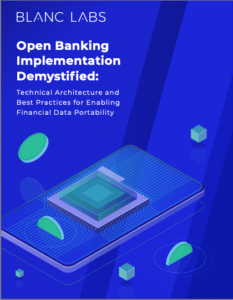 We also explore technology best practices to make your Open Banking adoption journey a success.
We also explore technology best practices to make your Open Banking adoption journey a success.